Sexual Harassment in the Workplace
VerifiedAdded on 2021/06/16
|19
|5316
|20
AI Summary
Contribute Materials
Your contribution can guide someone’s learning journey. Share your
documents today.
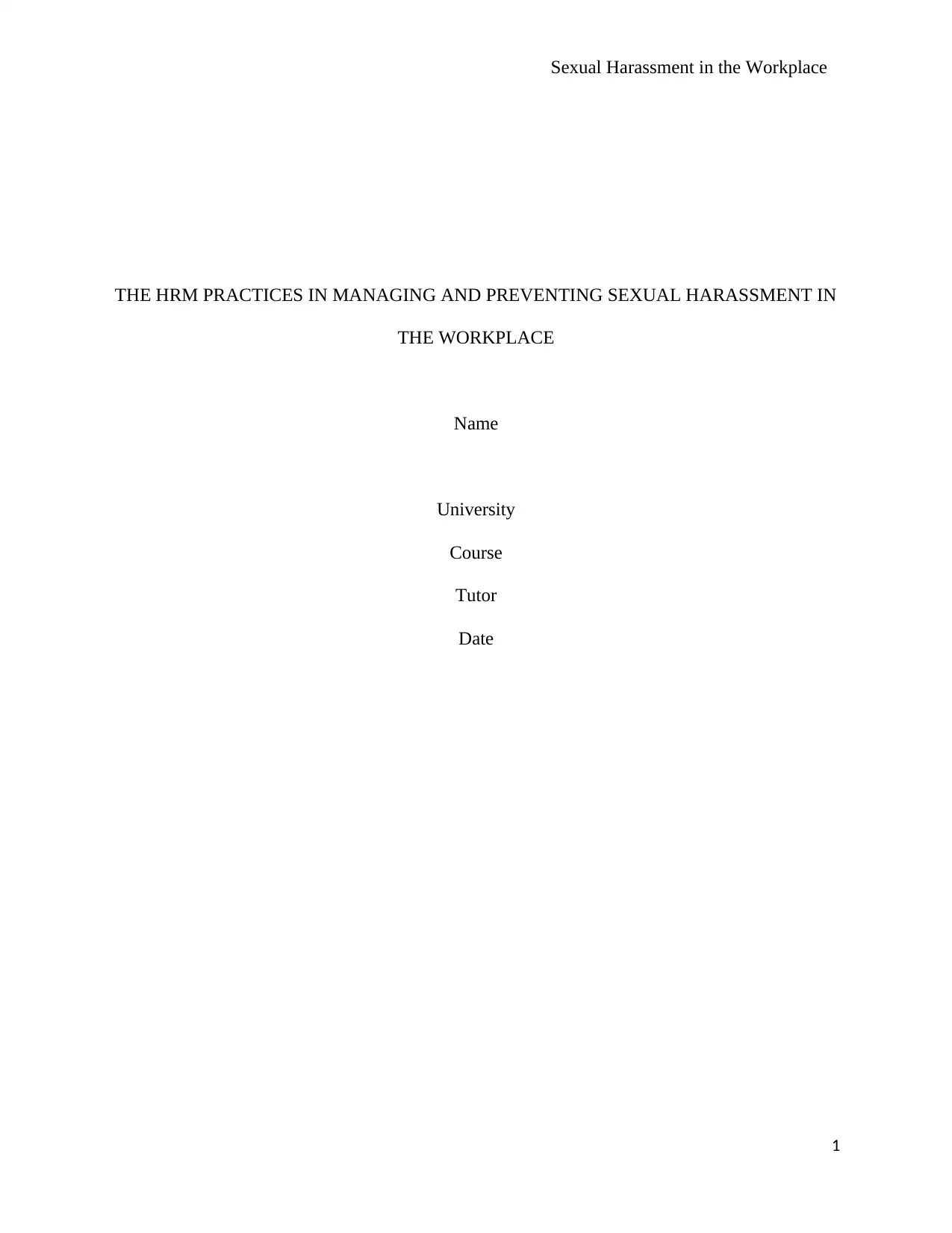
Sexual Harassment in the Workplace
THE HRM PRACTICES IN MANAGING AND PREVENTING SEXUAL HARASSMENT IN
THE WORKPLACE
Name
University
Course
Tutor
Date
1
THE HRM PRACTICES IN MANAGING AND PREVENTING SEXUAL HARASSMENT IN
THE WORKPLACE
Name
University
Course
Tutor
Date
1
Secure Best Marks with AI Grader
Need help grading? Try our AI Grader for instant feedback on your assignments.

Sexual Harassment in the Workplace
Abstract
Sexual harassment occurs in the workplace and the Anti‐Discrimination Act and commonwealth
sexual discrimination act were adopted to control and prevent the prevalence of sexual
harassment at workplace. The two bodies have raised awareness of the problem in the
organisation through campaigns and investigations done into companies that have sexual
harassment complaints. Organizations have also come up with policies and procedures to
manage and prevent the occurrence of sexual harassment in the workplace. Women have
reported high number of cases than men. It is noted that most men do not speak up in instances
of sexual harassment with fear of being labeled weak which is perceived by the society as no
masculine. Different organizations have set up training and created awareness of the sexual
harassment in the workplace for it to be safe for all workers to perform their tasks without fear of
victimization.
1.0. Introduction
Sexual harassment has existed in the workplace with the presence of both the sexes, despite laws
in place to prevent it. It is not a new phenomenon (McDonald 2012, p. 8). The past decades have
seen the entry of more women in the workplace and taking up occupations previously
monopolized by males. It has led to the increase in the prevalence of conflict between the
genders. The conflicts led to the development of bounds of acceptable behaviors at work. Sexual
harassment can include persons of the same sex, though the most reported cases involve females
harassed by males (McDonald & Dear 2009, p. 42). Most accounts of sexual harassment involve
physical assault. The harassment is not easily identified and are more subtle. Men have also
been victims of sexual harassment though they rarely report the cases. The report explores the
limitations of the job behaviors.
2
Abstract
Sexual harassment occurs in the workplace and the Anti‐Discrimination Act and commonwealth
sexual discrimination act were adopted to control and prevent the prevalence of sexual
harassment at workplace. The two bodies have raised awareness of the problem in the
organisation through campaigns and investigations done into companies that have sexual
harassment complaints. Organizations have also come up with policies and procedures to
manage and prevent the occurrence of sexual harassment in the workplace. Women have
reported high number of cases than men. It is noted that most men do not speak up in instances
of sexual harassment with fear of being labeled weak which is perceived by the society as no
masculine. Different organizations have set up training and created awareness of the sexual
harassment in the workplace for it to be safe for all workers to perform their tasks without fear of
victimization.
1.0. Introduction
Sexual harassment has existed in the workplace with the presence of both the sexes, despite laws
in place to prevent it. It is not a new phenomenon (McDonald 2012, p. 8). The past decades have
seen the entry of more women in the workplace and taking up occupations previously
monopolized by males. It has led to the increase in the prevalence of conflict between the
genders. The conflicts led to the development of bounds of acceptable behaviors at work. Sexual
harassment can include persons of the same sex, though the most reported cases involve females
harassed by males (McDonald & Dear 2009, p. 42). Most accounts of sexual harassment involve
physical assault. The harassment is not easily identified and are more subtle. Men have also
been victims of sexual harassment though they rarely report the cases. The report explores the
limitations of the job behaviors.
2
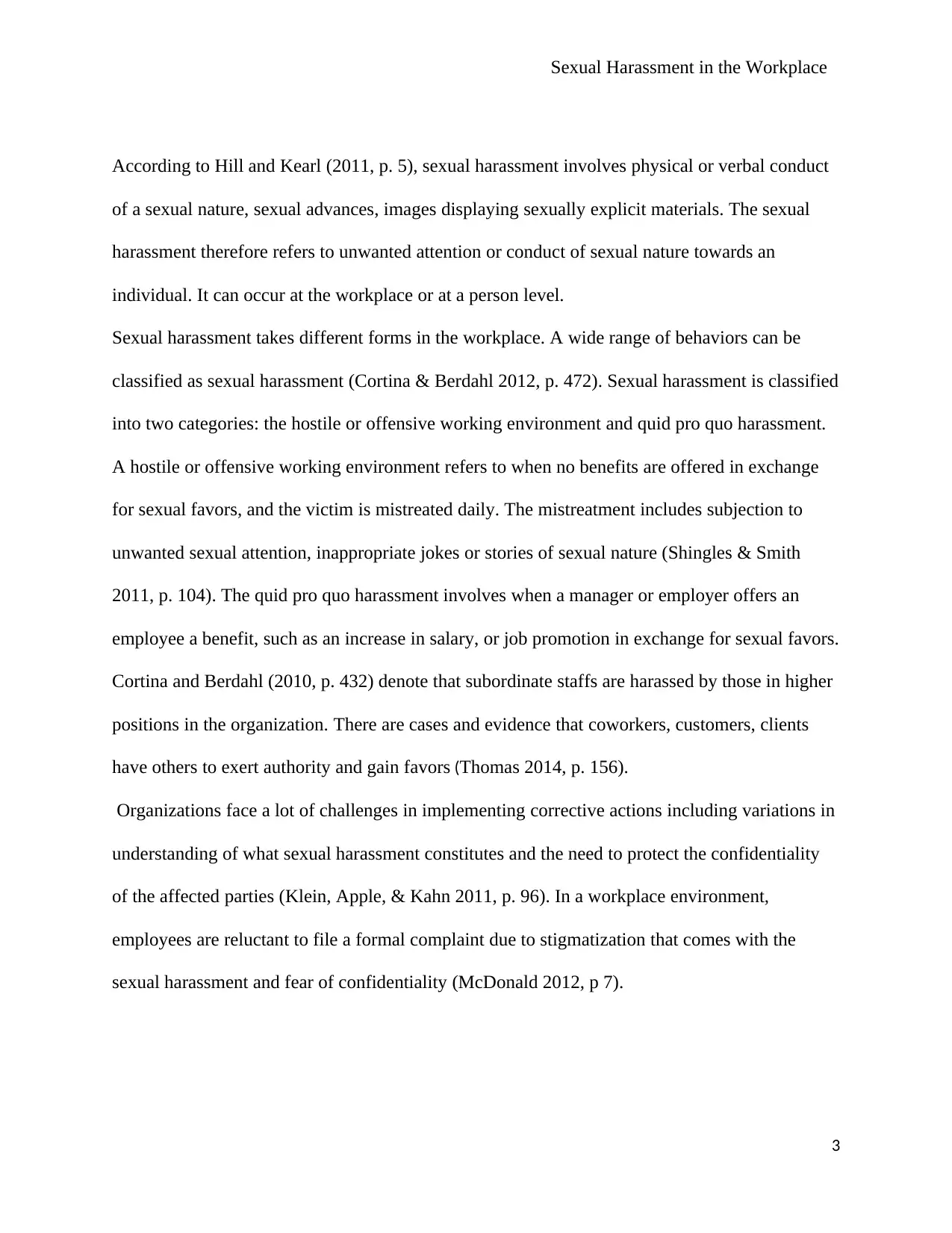
Sexual Harassment in the Workplace
According to Hill and Kearl (2011, p. 5), sexual harassment involves physical or verbal conduct
of a sexual nature, sexual advances, images displaying sexually explicit materials. The sexual
harassment therefore refers to unwanted attention or conduct of sexual nature towards an
individual. It can occur at the workplace or at a person level.
Sexual harassment takes different forms in the workplace. A wide range of behaviors can be
classified as sexual harassment (Cortina & Berdahl 2012, p. 472). Sexual harassment is classified
into two categories: the hostile or offensive working environment and quid pro quo harassment.
A hostile or offensive working environment refers to when no benefits are offered in exchange
for sexual favors, and the victim is mistreated daily. The mistreatment includes subjection to
unwanted sexual attention, inappropriate jokes or stories of sexual nature (Shingles & Smith
2011, p. 104). The quid pro quo harassment involves when a manager or employer offers an
employee a benefit, such as an increase in salary, or job promotion in exchange for sexual favors.
Cortina and Berdahl (2010, p. 432) denote that subordinate staffs are harassed by those in higher
positions in the organization. There are cases and evidence that coworkers, customers, clients
have others to exert authority and gain favors (Thomas 2014, p. 156).
Organizations face a lot of challenges in implementing corrective actions including variations in
understanding of what sexual harassment constitutes and the need to protect the confidentiality
of the affected parties (Klein, Apple, & Kahn 2011, p. 96). In a workplace environment,
employees are reluctant to file a formal complaint due to stigmatization that comes with the
sexual harassment and fear of confidentiality (McDonald 2012, p 7).
3
According to Hill and Kearl (2011, p. 5), sexual harassment involves physical or verbal conduct
of a sexual nature, sexual advances, images displaying sexually explicit materials. The sexual
harassment therefore refers to unwanted attention or conduct of sexual nature towards an
individual. It can occur at the workplace or at a person level.
Sexual harassment takes different forms in the workplace. A wide range of behaviors can be
classified as sexual harassment (Cortina & Berdahl 2012, p. 472). Sexual harassment is classified
into two categories: the hostile or offensive working environment and quid pro quo harassment.
A hostile or offensive working environment refers to when no benefits are offered in exchange
for sexual favors, and the victim is mistreated daily. The mistreatment includes subjection to
unwanted sexual attention, inappropriate jokes or stories of sexual nature (Shingles & Smith
2011, p. 104). The quid pro quo harassment involves when a manager or employer offers an
employee a benefit, such as an increase in salary, or job promotion in exchange for sexual favors.
Cortina and Berdahl (2010, p. 432) denote that subordinate staffs are harassed by those in higher
positions in the organization. There are cases and evidence that coworkers, customers, clients
have others to exert authority and gain favors (Thomas 2014, p. 156).
Organizations face a lot of challenges in implementing corrective actions including variations in
understanding of what sexual harassment constitutes and the need to protect the confidentiality
of the affected parties (Klein, Apple, & Kahn 2011, p. 96). In a workplace environment,
employees are reluctant to file a formal complaint due to stigmatization that comes with the
sexual harassment and fear of confidentiality (McDonald 2012, p 7).
3
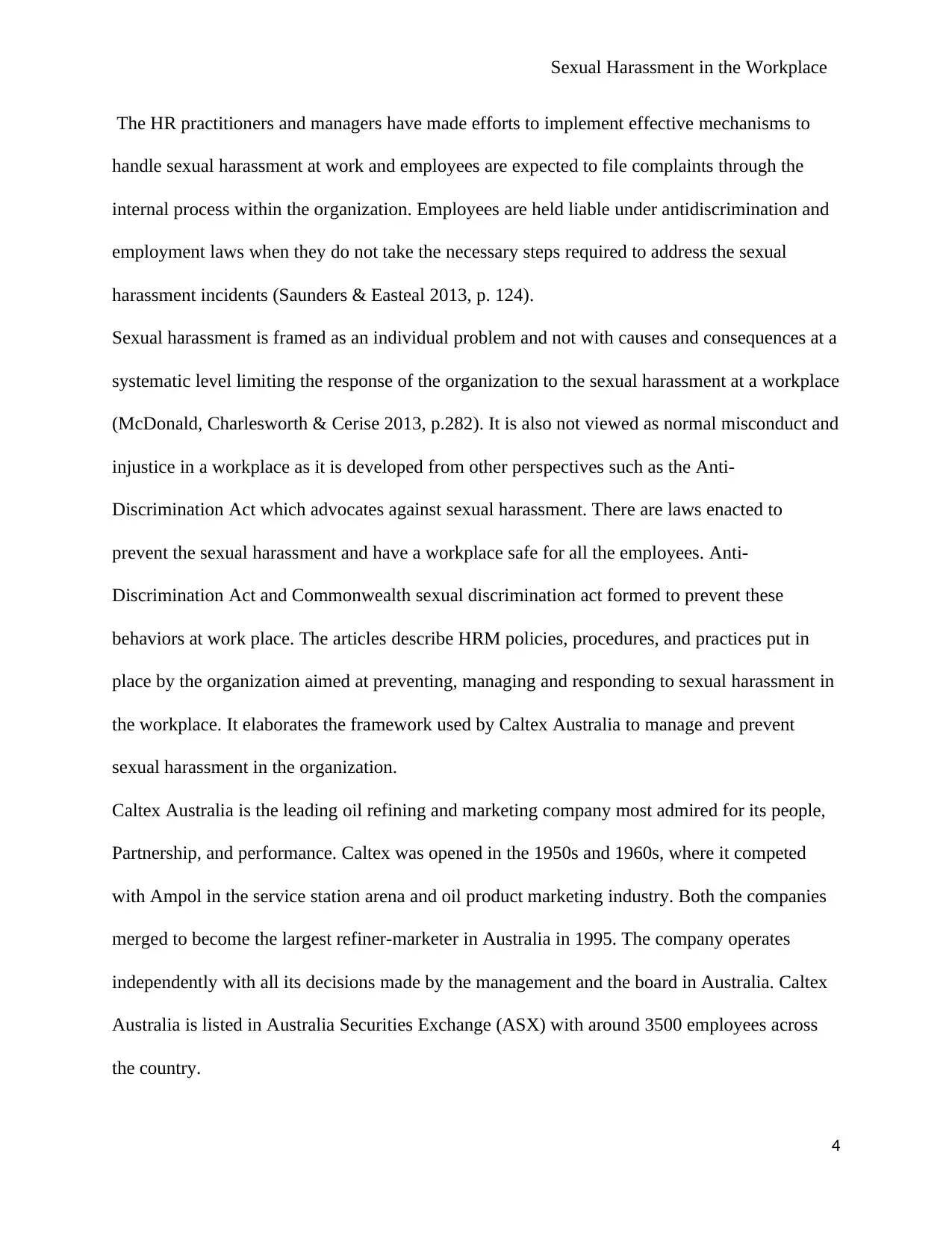
Sexual Harassment in the Workplace
The HR practitioners and managers have made efforts to implement effective mechanisms to
handle sexual harassment at work and employees are expected to file complaints through the
internal process within the organization. Employees are held liable under antidiscrimination and
employment laws when they do not take the necessary steps required to address the sexual
harassment incidents (Saunders & Easteal 2013, p. 124).
Sexual harassment is framed as an individual problem and not with causes and consequences at a
systematic level limiting the response of the organization to the sexual harassment at a workplace
(McDonald, Charlesworth & Cerise 2013, p.282). It is also not viewed as normal misconduct and
injustice in a workplace as it is developed from other perspectives such as the Anti‐
Discrimination Act which advocates against sexual harassment. There are laws enacted to
prevent the sexual harassment and have a workplace safe for all the employees. Anti‐
Discrimination Act and Commonwealth sexual discrimination act formed to prevent these
behaviors at work place. The articles describe HRM policies, procedures, and practices put in
place by the organization aimed at preventing, managing and responding to sexual harassment in
the workplace. It elaborates the framework used by Caltex Australia to manage and prevent
sexual harassment in the organization.
Caltex Australia is the leading oil refining and marketing company most admired for its people,
Partnership, and performance. Caltex was opened in the 1950s and 1960s, where it competed
with Ampol in the service station arena and oil product marketing industry. Both the companies
merged to become the largest refiner-marketer in Australia in 1995. The company operates
independently with all its decisions made by the management and the board in Australia. Caltex
Australia is listed in Australia Securities Exchange (ASX) with around 3500 employees across
the country.
4
The HR practitioners and managers have made efforts to implement effective mechanisms to
handle sexual harassment at work and employees are expected to file complaints through the
internal process within the organization. Employees are held liable under antidiscrimination and
employment laws when they do not take the necessary steps required to address the sexual
harassment incidents (Saunders & Easteal 2013, p. 124).
Sexual harassment is framed as an individual problem and not with causes and consequences at a
systematic level limiting the response of the organization to the sexual harassment at a workplace
(McDonald, Charlesworth & Cerise 2013, p.282). It is also not viewed as normal misconduct and
injustice in a workplace as it is developed from other perspectives such as the Anti‐
Discrimination Act which advocates against sexual harassment. There are laws enacted to
prevent the sexual harassment and have a workplace safe for all the employees. Anti‐
Discrimination Act and Commonwealth sexual discrimination act formed to prevent these
behaviors at work place. The articles describe HRM policies, procedures, and practices put in
place by the organization aimed at preventing, managing and responding to sexual harassment in
the workplace. It elaborates the framework used by Caltex Australia to manage and prevent
sexual harassment in the organization.
Caltex Australia is the leading oil refining and marketing company most admired for its people,
Partnership, and performance. Caltex was opened in the 1950s and 1960s, where it competed
with Ampol in the service station arena and oil product marketing industry. Both the companies
merged to become the largest refiner-marketer in Australia in 1995. The company operates
independently with all its decisions made by the management and the board in Australia. Caltex
Australia is listed in Australia Securities Exchange (ASX) with around 3500 employees across
the country.
4
Secure Best Marks with AI Grader
Need help grading? Try our AI Grader for instant feedback on your assignments.
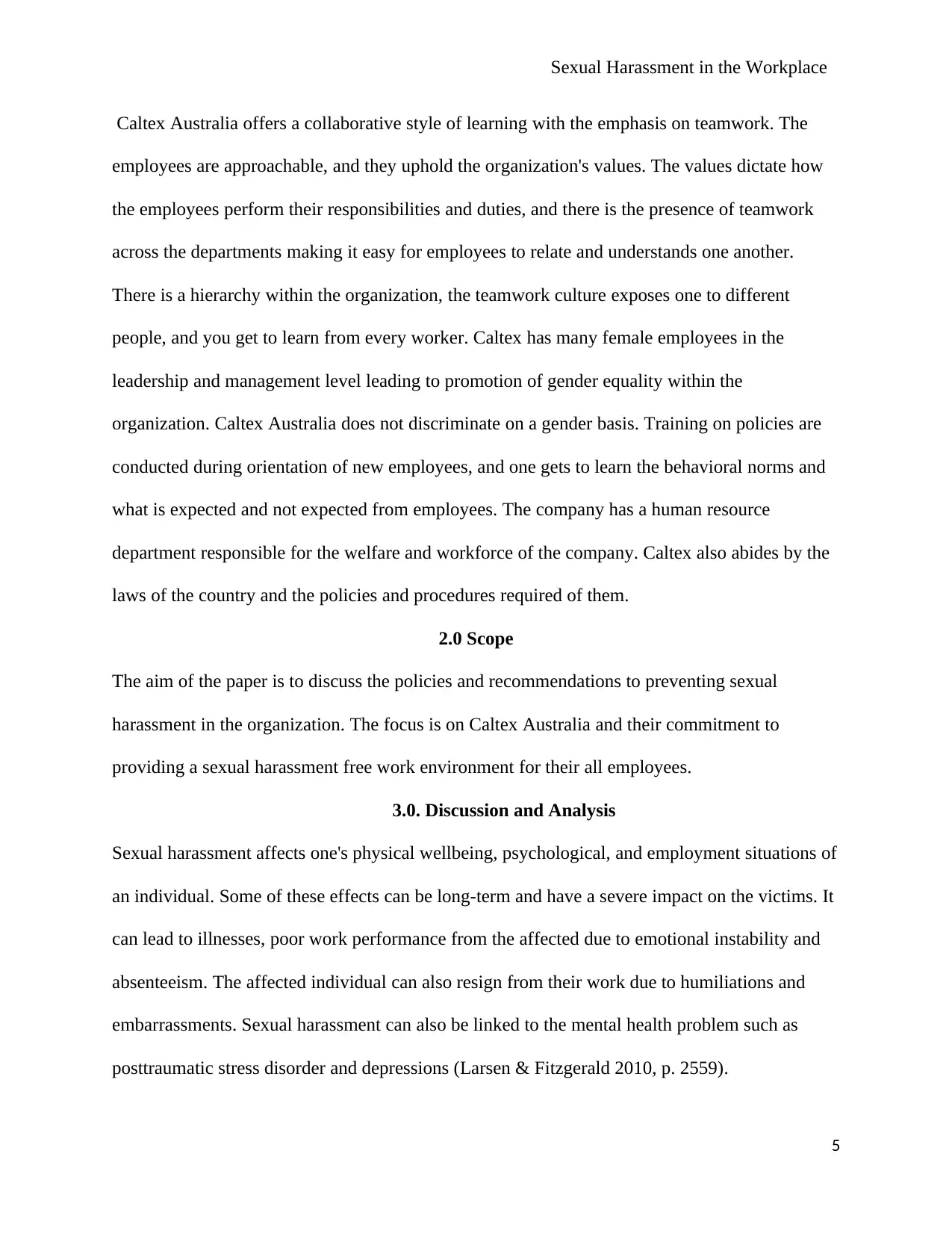
Sexual Harassment in the Workplace
Caltex Australia offers a collaborative style of learning with the emphasis on teamwork. The
employees are approachable, and they uphold the organization's values. The values dictate how
the employees perform their responsibilities and duties, and there is the presence of teamwork
across the departments making it easy for employees to relate and understands one another.
There is a hierarchy within the organization, the teamwork culture exposes one to different
people, and you get to learn from every worker. Caltex has many female employees in the
leadership and management level leading to promotion of gender equality within the
organization. Caltex Australia does not discriminate on a gender basis. Training on policies are
conducted during orientation of new employees, and one gets to learn the behavioral norms and
what is expected and not expected from employees. The company has a human resource
department responsible for the welfare and workforce of the company. Caltex also abides by the
laws of the country and the policies and procedures required of them.
2.0 Scope
The aim of the paper is to discuss the policies and recommendations to preventing sexual
harassment in the organization. The focus is on Caltex Australia and their commitment to
providing a sexual harassment free work environment for their all employees.
3.0. Discussion and Analysis
Sexual harassment affects one's physical wellbeing, psychological, and employment situations of
an individual. Some of these effects can be long-term and have a severe impact on the victims. It
can lead to illnesses, poor work performance from the affected due to emotional instability and
absenteeism. The affected individual can also resign from their work due to humiliations and
embarrassments. Sexual harassment can also be linked to the mental health problem such as
posttraumatic stress disorder and depressions (Larsen & Fitzgerald 2010, p. 2559).
5
Caltex Australia offers a collaborative style of learning with the emphasis on teamwork. The
employees are approachable, and they uphold the organization's values. The values dictate how
the employees perform their responsibilities and duties, and there is the presence of teamwork
across the departments making it easy for employees to relate and understands one another.
There is a hierarchy within the organization, the teamwork culture exposes one to different
people, and you get to learn from every worker. Caltex has many female employees in the
leadership and management level leading to promotion of gender equality within the
organization. Caltex Australia does not discriminate on a gender basis. Training on policies are
conducted during orientation of new employees, and one gets to learn the behavioral norms and
what is expected and not expected from employees. The company has a human resource
department responsible for the welfare and workforce of the company. Caltex also abides by the
laws of the country and the policies and procedures required of them.
2.0 Scope
The aim of the paper is to discuss the policies and recommendations to preventing sexual
harassment in the organization. The focus is on Caltex Australia and their commitment to
providing a sexual harassment free work environment for their all employees.
3.0. Discussion and Analysis
Sexual harassment affects one's physical wellbeing, psychological, and employment situations of
an individual. Some of these effects can be long-term and have a severe impact on the victims. It
can lead to illnesses, poor work performance from the affected due to emotional instability and
absenteeism. The affected individual can also resign from their work due to humiliations and
embarrassments. Sexual harassment can also be linked to the mental health problem such as
posttraumatic stress disorder and depressions (Larsen & Fitzgerald 2010, p. 2559).
5
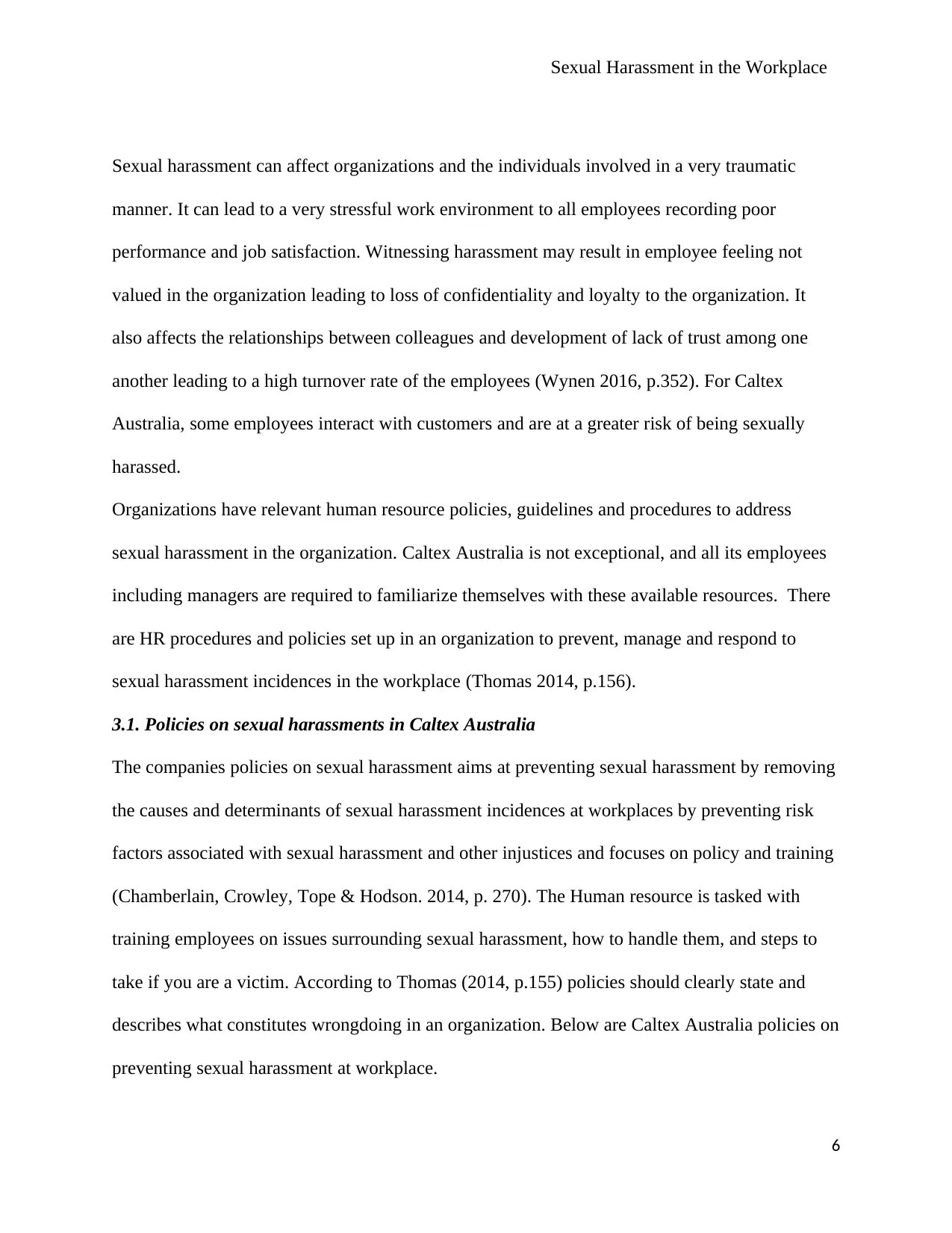
Sexual Harassment in the Workplace
Sexual harassment can affect organizations and the individuals involved in a very traumatic
manner. It can lead to a very stressful work environment to all employees recording poor
performance and job satisfaction. Witnessing harassment may result in employee feeling not
valued in the organization leading to loss of confidentiality and loyalty to the organization. It
also affects the relationships between colleagues and development of lack of trust among one
another leading to a high turnover rate of the employees (Wynen 2016, p.352). For Caltex
Australia, some employees interact with customers and are at a greater risk of being sexually
harassed.
Organizations have relevant human resource policies, guidelines and procedures to address
sexual harassment in the organization. Caltex Australia is not exceptional, and all its employees
including managers are required to familiarize themselves with these available resources. There
are HR procedures and policies set up in an organization to prevent, manage and respond to
sexual harassment incidences in the workplace (Thomas 2014, p.156).
3.1. Policies on sexual harassments in Caltex Australia
The companies policies on sexual harassment aims at preventing sexual harassment by removing
the causes and determinants of sexual harassment incidences at workplaces by preventing risk
factors associated with sexual harassment and other injustices and focuses on policy and training
(Chamberlain, Crowley, Tope & Hodson. 2014, p. 270). The Human resource is tasked with
training employees on issues surrounding sexual harassment, how to handle them, and steps to
take if you are a victim. According to Thomas (2014, p.155) policies should clearly state and
describes what constitutes wrongdoing in an organization. Below are Caltex Australia policies on
preventing sexual harassment at workplace.
6
Sexual harassment can affect organizations and the individuals involved in a very traumatic
manner. It can lead to a very stressful work environment to all employees recording poor
performance and job satisfaction. Witnessing harassment may result in employee feeling not
valued in the organization leading to loss of confidentiality and loyalty to the organization. It
also affects the relationships between colleagues and development of lack of trust among one
another leading to a high turnover rate of the employees (Wynen 2016, p.352). For Caltex
Australia, some employees interact with customers and are at a greater risk of being sexually
harassed.
Organizations have relevant human resource policies, guidelines and procedures to address
sexual harassment in the organization. Caltex Australia is not exceptional, and all its employees
including managers are required to familiarize themselves with these available resources. There
are HR procedures and policies set up in an organization to prevent, manage and respond to
sexual harassment incidences in the workplace (Thomas 2014, p.156).
3.1. Policies on sexual harassments in Caltex Australia
The companies policies on sexual harassment aims at preventing sexual harassment by removing
the causes and determinants of sexual harassment incidences at workplaces by preventing risk
factors associated with sexual harassment and other injustices and focuses on policy and training
(Chamberlain, Crowley, Tope & Hodson. 2014, p. 270). The Human resource is tasked with
training employees on issues surrounding sexual harassment, how to handle them, and steps to
take if you are a victim. According to Thomas (2014, p.155) policies should clearly state and
describes what constitutes wrongdoing in an organization. Below are Caltex Australia policies on
preventing sexual harassment at workplace.
6
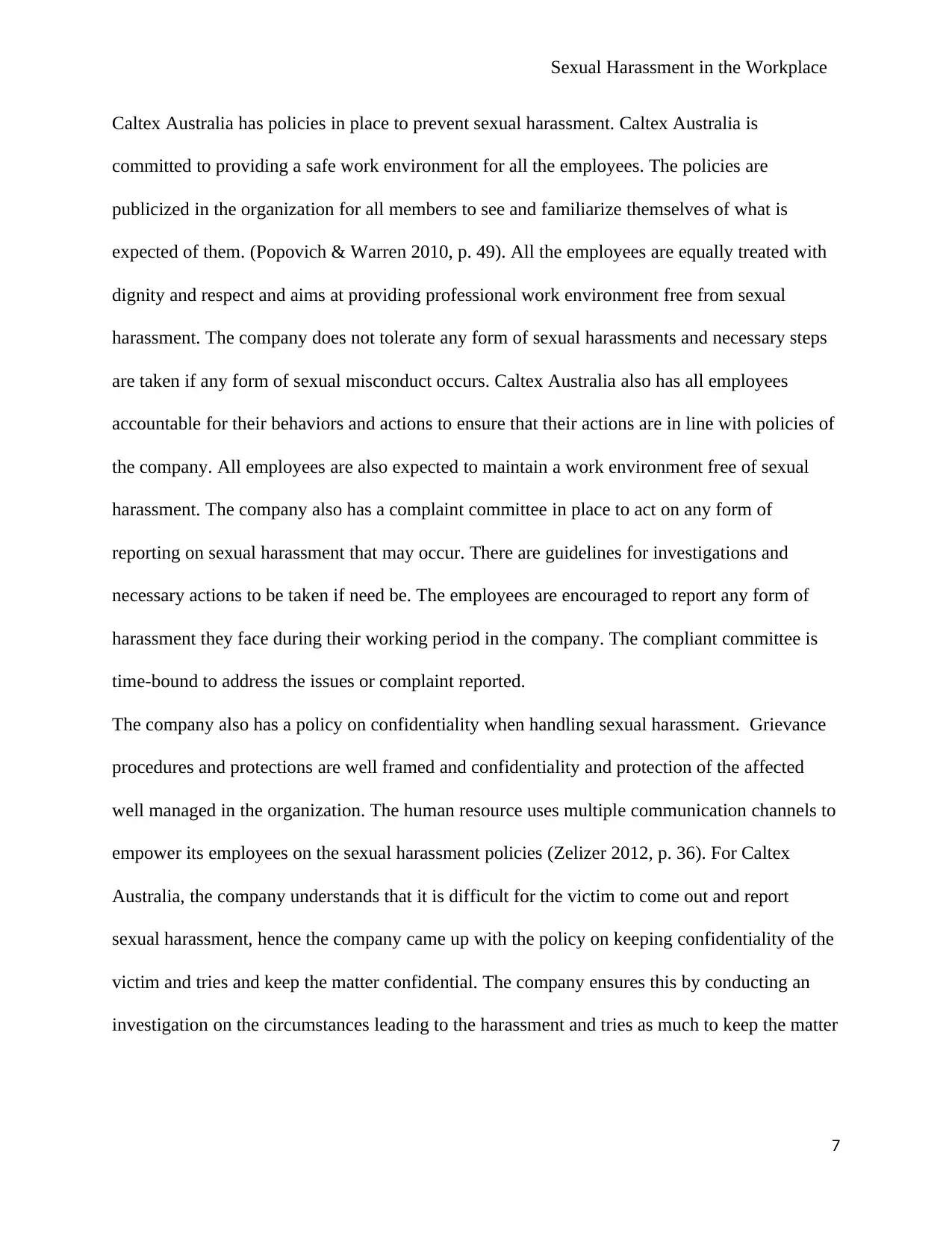
Sexual Harassment in the Workplace
Caltex Australia has policies in place to prevent sexual harassment. Caltex Australia is
committed to providing a safe work environment for all the employees. The policies are
publicized in the organization for all members to see and familiarize themselves of what is
expected of them. (Popovich & Warren 2010, p. 49). All the employees are equally treated with
dignity and respect and aims at providing professional work environment free from sexual
harassment. The company does not tolerate any form of sexual harassments and necessary steps
are taken if any form of sexual misconduct occurs. Caltex Australia also has all employees
accountable for their behaviors and actions to ensure that their actions are in line with policies of
the company. All employees are also expected to maintain a work environment free of sexual
harassment. The company also has a complaint committee in place to act on any form of
reporting on sexual harassment that may occur. There are guidelines for investigations and
necessary actions to be taken if need be. The employees are encouraged to report any form of
harassment they face during their working period in the company. The compliant committee is
time-bound to address the issues or complaint reported.
The company also has a policy on confidentiality when handling sexual harassment. Grievance
procedures and protections are well framed and confidentiality and protection of the affected
well managed in the organization. The human resource uses multiple communication channels to
empower its employees on the sexual harassment policies (Zelizer 2012, p. 36). For Caltex
Australia, the company understands that it is difficult for the victim to come out and report
sexual harassment, hence the company came up with the policy on keeping confidentiality of the
victim and tries and keep the matter confidential. The company ensures this by conducting an
investigation on the circumstances leading to the harassment and tries as much to keep the matter
7
Caltex Australia has policies in place to prevent sexual harassment. Caltex Australia is
committed to providing a safe work environment for all the employees. The policies are
publicized in the organization for all members to see and familiarize themselves of what is
expected of them. (Popovich & Warren 2010, p. 49). All the employees are equally treated with
dignity and respect and aims at providing professional work environment free from sexual
harassment. The company does not tolerate any form of sexual harassments and necessary steps
are taken if any form of sexual misconduct occurs. Caltex Australia also has all employees
accountable for their behaviors and actions to ensure that their actions are in line with policies of
the company. All employees are also expected to maintain a work environment free of sexual
harassment. The company also has a complaint committee in place to act on any form of
reporting on sexual harassment that may occur. There are guidelines for investigations and
necessary actions to be taken if need be. The employees are encouraged to report any form of
harassment they face during their working period in the company. The compliant committee is
time-bound to address the issues or complaint reported.
The company also has a policy on confidentiality when handling sexual harassment. Grievance
procedures and protections are well framed and confidentiality and protection of the affected
well managed in the organization. The human resource uses multiple communication channels to
empower its employees on the sexual harassment policies (Zelizer 2012, p. 36). For Caltex
Australia, the company understands that it is difficult for the victim to come out and report
sexual harassment, hence the company came up with the policy on keeping confidentiality of the
victim and tries and keep the matter confidential. The company ensures this by conducting an
investigation on the circumstances leading to the harassment and tries as much to keep the matter
7
Paraphrase This Document
Need a fresh take? Get an instant paraphrase of this document with our AI Paraphraser
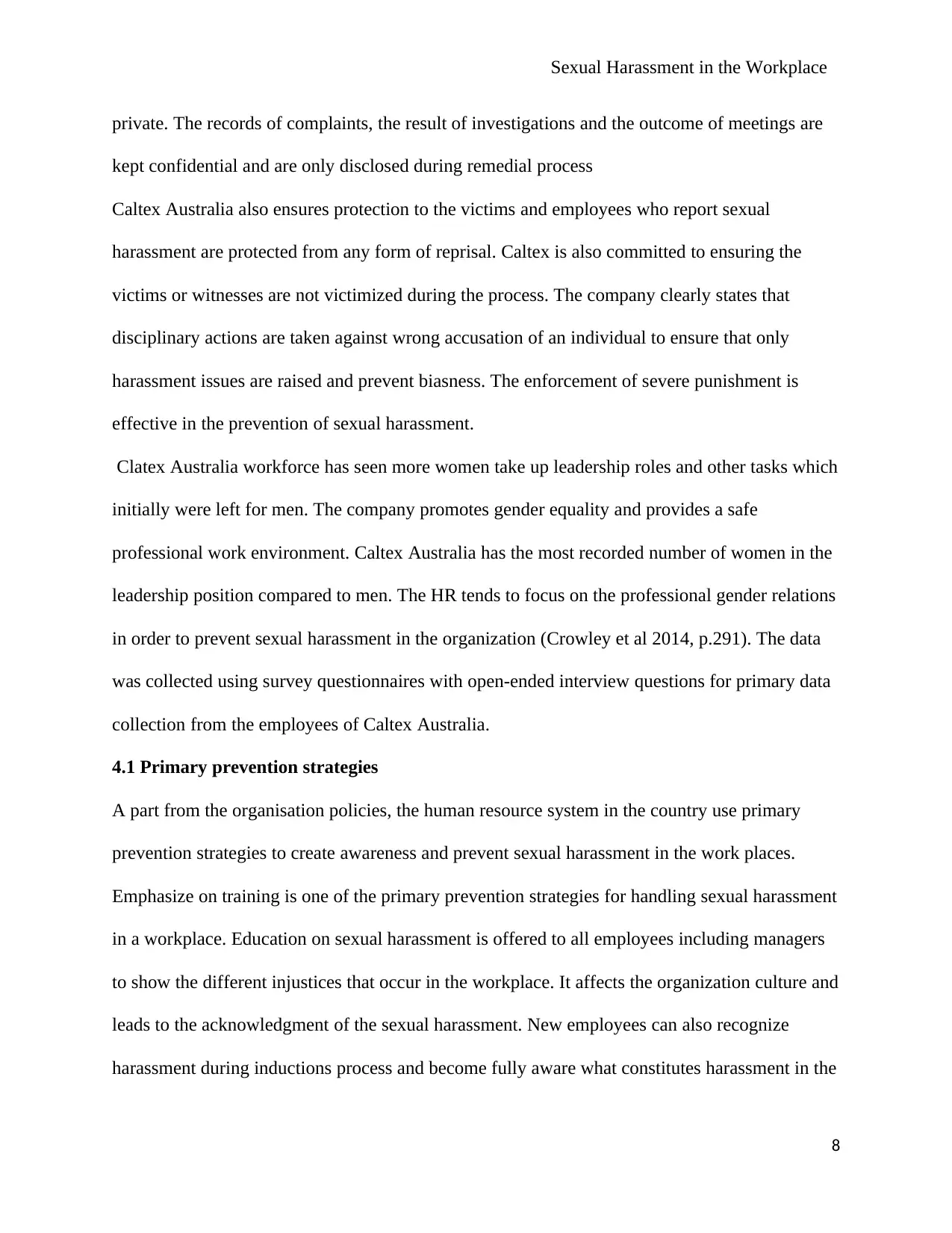
Sexual Harassment in the Workplace
private. The records of complaints, the result of investigations and the outcome of meetings are
kept confidential and are only disclosed during remedial process
Caltex Australia also ensures protection to the victims and employees who report sexual
harassment are protected from any form of reprisal. Caltex is also committed to ensuring the
victims or witnesses are not victimized during the process. The company clearly states that
disciplinary actions are taken against wrong accusation of an individual to ensure that only
harassment issues are raised and prevent biasness. The enforcement of severe punishment is
effective in the prevention of sexual harassment.
Clatex Australia workforce has seen more women take up leadership roles and other tasks which
initially were left for men. The company promotes gender equality and provides a safe
professional work environment. Caltex Australia has the most recorded number of women in the
leadership position compared to men. The HR tends to focus on the professional gender relations
in order to prevent sexual harassment in the organization (Crowley et al 2014, p.291). The data
was collected using survey questionnaires with open-ended interview questions for primary data
collection from the employees of Caltex Australia.
4.1 Primary prevention strategies
A part from the organisation policies, the human resource system in the country use primary
prevention strategies to create awareness and prevent sexual harassment in the work places.
Emphasize on training is one of the primary prevention strategies for handling sexual harassment
in a workplace. Education on sexual harassment is offered to all employees including managers
to show the different injustices that occur in the workplace. It affects the organization culture and
leads to the acknowledgment of the sexual harassment. New employees can also recognize
harassment during inductions process and become fully aware what constitutes harassment in the
8
private. The records of complaints, the result of investigations and the outcome of meetings are
kept confidential and are only disclosed during remedial process
Caltex Australia also ensures protection to the victims and employees who report sexual
harassment are protected from any form of reprisal. Caltex is also committed to ensuring the
victims or witnesses are not victimized during the process. The company clearly states that
disciplinary actions are taken against wrong accusation of an individual to ensure that only
harassment issues are raised and prevent biasness. The enforcement of severe punishment is
effective in the prevention of sexual harassment.
Clatex Australia workforce has seen more women take up leadership roles and other tasks which
initially were left for men. The company promotes gender equality and provides a safe
professional work environment. Caltex Australia has the most recorded number of women in the
leadership position compared to men. The HR tends to focus on the professional gender relations
in order to prevent sexual harassment in the organization (Crowley et al 2014, p.291). The data
was collected using survey questionnaires with open-ended interview questions for primary data
collection from the employees of Caltex Australia.
4.1 Primary prevention strategies
A part from the organisation policies, the human resource system in the country use primary
prevention strategies to create awareness and prevent sexual harassment in the work places.
Emphasize on training is one of the primary prevention strategies for handling sexual harassment
in a workplace. Education on sexual harassment is offered to all employees including managers
to show the different injustices that occur in the workplace. It affects the organization culture and
leads to the acknowledgment of the sexual harassment. New employees can also recognize
harassment during inductions process and become fully aware what constitutes harassment in the
8
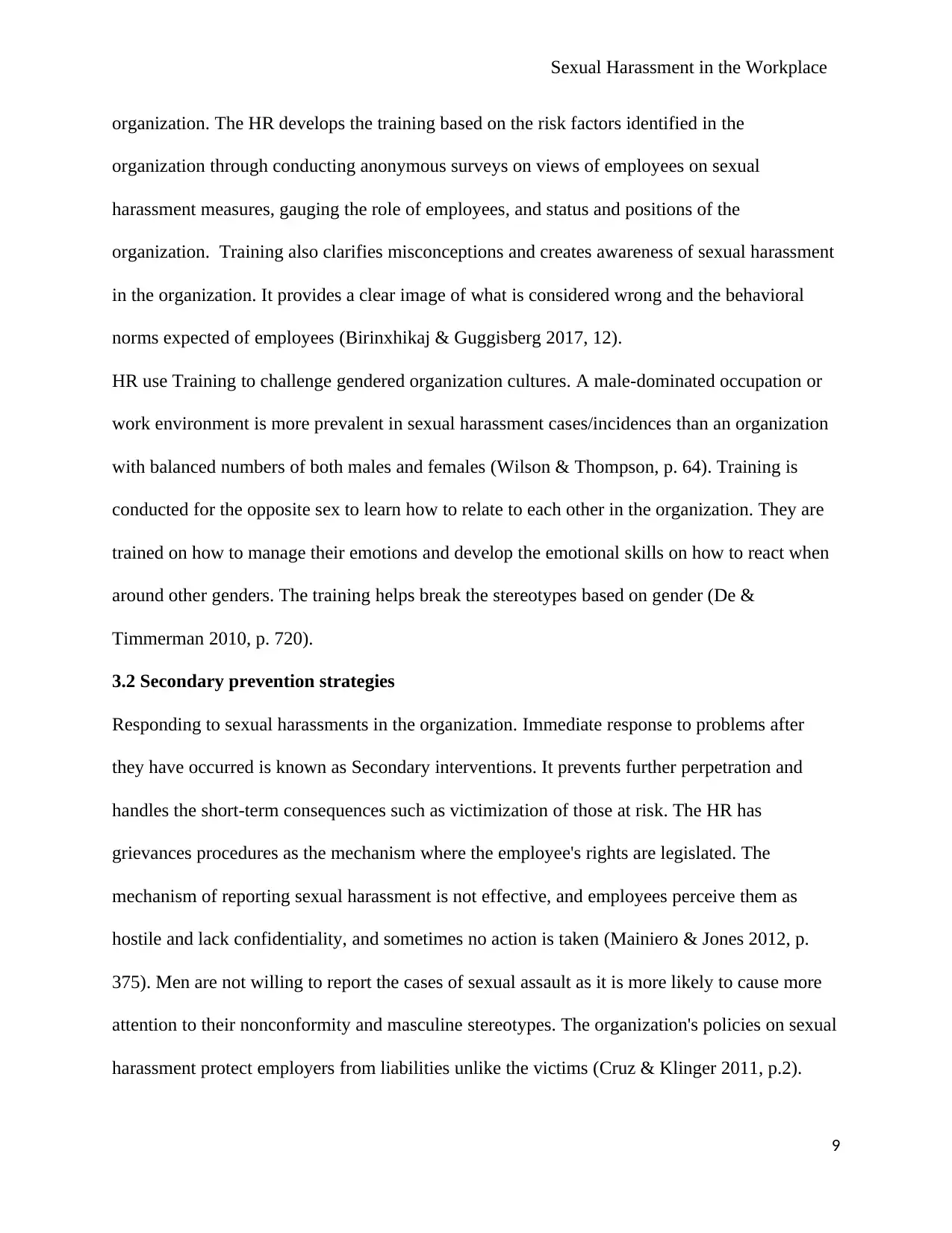
Sexual Harassment in the Workplace
organization. The HR develops the training based on the risk factors identified in the
organization through conducting anonymous surveys on views of employees on sexual
harassment measures, gauging the role of employees, and status and positions of the
organization. Training also clarifies misconceptions and creates awareness of sexual harassment
in the organization. It provides a clear image of what is considered wrong and the behavioral
norms expected of employees (Birinxhikaj & Guggisberg 2017, 12).
HR use Training to challenge gendered organization cultures. A male-dominated occupation or
work environment is more prevalent in sexual harassment cases/incidences than an organization
with balanced numbers of both males and females (Wilson & Thompson, p. 64). Training is
conducted for the opposite sex to learn how to relate to each other in the organization. They are
trained on how to manage their emotions and develop the emotional skills on how to react when
around other genders. The training helps break the stereotypes based on gender (De &
Timmerman 2010, p. 720).
3.2 Secondary prevention strategies
Responding to sexual harassments in the organization. Immediate response to problems after
they have occurred is known as Secondary interventions. It prevents further perpetration and
handles the short-term consequences such as victimization of those at risk. The HR has
grievances procedures as the mechanism where the employee's rights are legislated. The
mechanism of reporting sexual harassment is not effective, and employees perceive them as
hostile and lack confidentiality, and sometimes no action is taken (Mainiero & Jones 2012, p.
375). Men are not willing to report the cases of sexual assault as it is more likely to cause more
attention to their nonconformity and masculine stereotypes. The organization's policies on sexual
harassment protect employers from liabilities unlike the victims (Cruz & Klinger 2011, p.2).
9
organization. The HR develops the training based on the risk factors identified in the
organization through conducting anonymous surveys on views of employees on sexual
harassment measures, gauging the role of employees, and status and positions of the
organization. Training also clarifies misconceptions and creates awareness of sexual harassment
in the organization. It provides a clear image of what is considered wrong and the behavioral
norms expected of employees (Birinxhikaj & Guggisberg 2017, 12).
HR use Training to challenge gendered organization cultures. A male-dominated occupation or
work environment is more prevalent in sexual harassment cases/incidences than an organization
with balanced numbers of both males and females (Wilson & Thompson, p. 64). Training is
conducted for the opposite sex to learn how to relate to each other in the organization. They are
trained on how to manage their emotions and develop the emotional skills on how to react when
around other genders. The training helps break the stereotypes based on gender (De &
Timmerman 2010, p. 720).
3.2 Secondary prevention strategies
Responding to sexual harassments in the organization. Immediate response to problems after
they have occurred is known as Secondary interventions. It prevents further perpetration and
handles the short-term consequences such as victimization of those at risk. The HR has
grievances procedures as the mechanism where the employee's rights are legislated. The
mechanism of reporting sexual harassment is not effective, and employees perceive them as
hostile and lack confidentiality, and sometimes no action is taken (Mainiero & Jones 2012, p.
375). Men are not willing to report the cases of sexual assault as it is more likely to cause more
attention to their nonconformity and masculine stereotypes. The organization's policies on sexual
harassment protect employers from liabilities unlike the victims (Cruz & Klinger 2011, p.2).
9
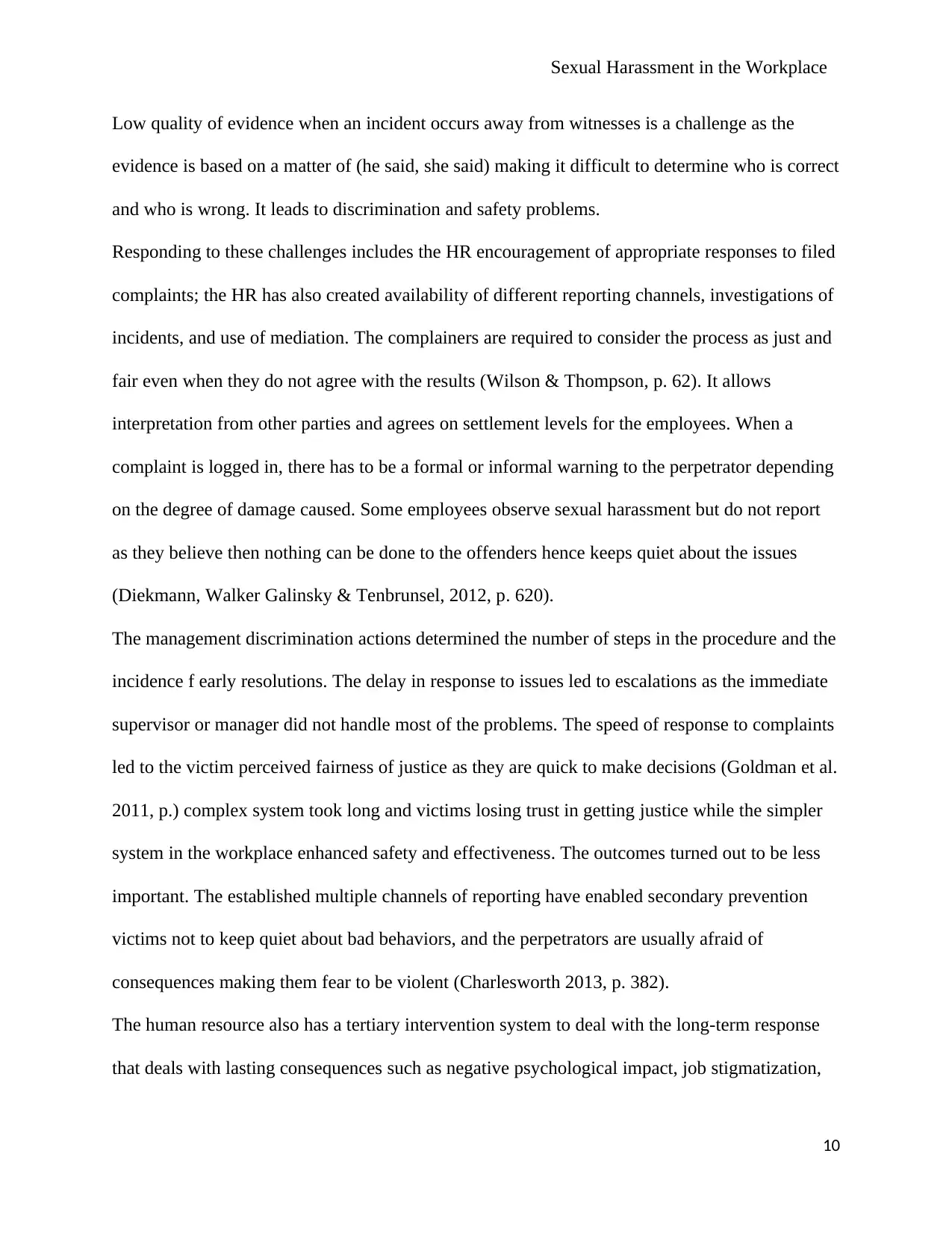
Sexual Harassment in the Workplace
Low quality of evidence when an incident occurs away from witnesses is a challenge as the
evidence is based on a matter of (he said, she said) making it difficult to determine who is correct
and who is wrong. It leads to discrimination and safety problems.
Responding to these challenges includes the HR encouragement of appropriate responses to filed
complaints; the HR has also created availability of different reporting channels, investigations of
incidents, and use of mediation. The complainers are required to consider the process as just and
fair even when they do not agree with the results (Wilson & Thompson, p. 62). It allows
interpretation from other parties and agrees on settlement levels for the employees. When a
complaint is logged in, there has to be a formal or informal warning to the perpetrator depending
on the degree of damage caused. Some employees observe sexual harassment but do not report
as they believe then nothing can be done to the offenders hence keeps quiet about the issues
(Diekmann, Walker Galinsky & Tenbrunsel, 2012, p. 620).
The management discrimination actions determined the number of steps in the procedure and the
incidence f early resolutions. The delay in response to issues led to escalations as the immediate
supervisor or manager did not handle most of the problems. The speed of response to complaints
led to the victim perceived fairness of justice as they are quick to make decisions (Goldman et al.
2011, p.) complex system took long and victims losing trust in getting justice while the simpler
system in the workplace enhanced safety and effectiveness. The outcomes turned out to be less
important. The established multiple channels of reporting have enabled secondary prevention
victims not to keep quiet about bad behaviors, and the perpetrators are usually afraid of
consequences making them fear to be violent (Charlesworth 2013, p. 382).
The human resource also has a tertiary intervention system to deal with the long-term response
that deals with lasting consequences such as negative psychological impact, job stigmatization,
10
Low quality of evidence when an incident occurs away from witnesses is a challenge as the
evidence is based on a matter of (he said, she said) making it difficult to determine who is correct
and who is wrong. It leads to discrimination and safety problems.
Responding to these challenges includes the HR encouragement of appropriate responses to filed
complaints; the HR has also created availability of different reporting channels, investigations of
incidents, and use of mediation. The complainers are required to consider the process as just and
fair even when they do not agree with the results (Wilson & Thompson, p. 62). It allows
interpretation from other parties and agrees on settlement levels for the employees. When a
complaint is logged in, there has to be a formal or informal warning to the perpetrator depending
on the degree of damage caused. Some employees observe sexual harassment but do not report
as they believe then nothing can be done to the offenders hence keeps quiet about the issues
(Diekmann, Walker Galinsky & Tenbrunsel, 2012, p. 620).
The management discrimination actions determined the number of steps in the procedure and the
incidence f early resolutions. The delay in response to issues led to escalations as the immediate
supervisor or manager did not handle most of the problems. The speed of response to complaints
led to the victim perceived fairness of justice as they are quick to make decisions (Goldman et al.
2011, p.) complex system took long and victims losing trust in getting justice while the simpler
system in the workplace enhanced safety and effectiveness. The outcomes turned out to be less
important. The established multiple channels of reporting have enabled secondary prevention
victims not to keep quiet about bad behaviors, and the perpetrators are usually afraid of
consequences making them fear to be violent (Charlesworth 2013, p. 382).
The human resource also has a tertiary intervention system to deal with the long-term response
that deals with lasting consequences such as negative psychological impact, job stigmatization,
10
Secure Best Marks with AI Grader
Need help grading? Try our AI Grader for instant feedback on your assignments.
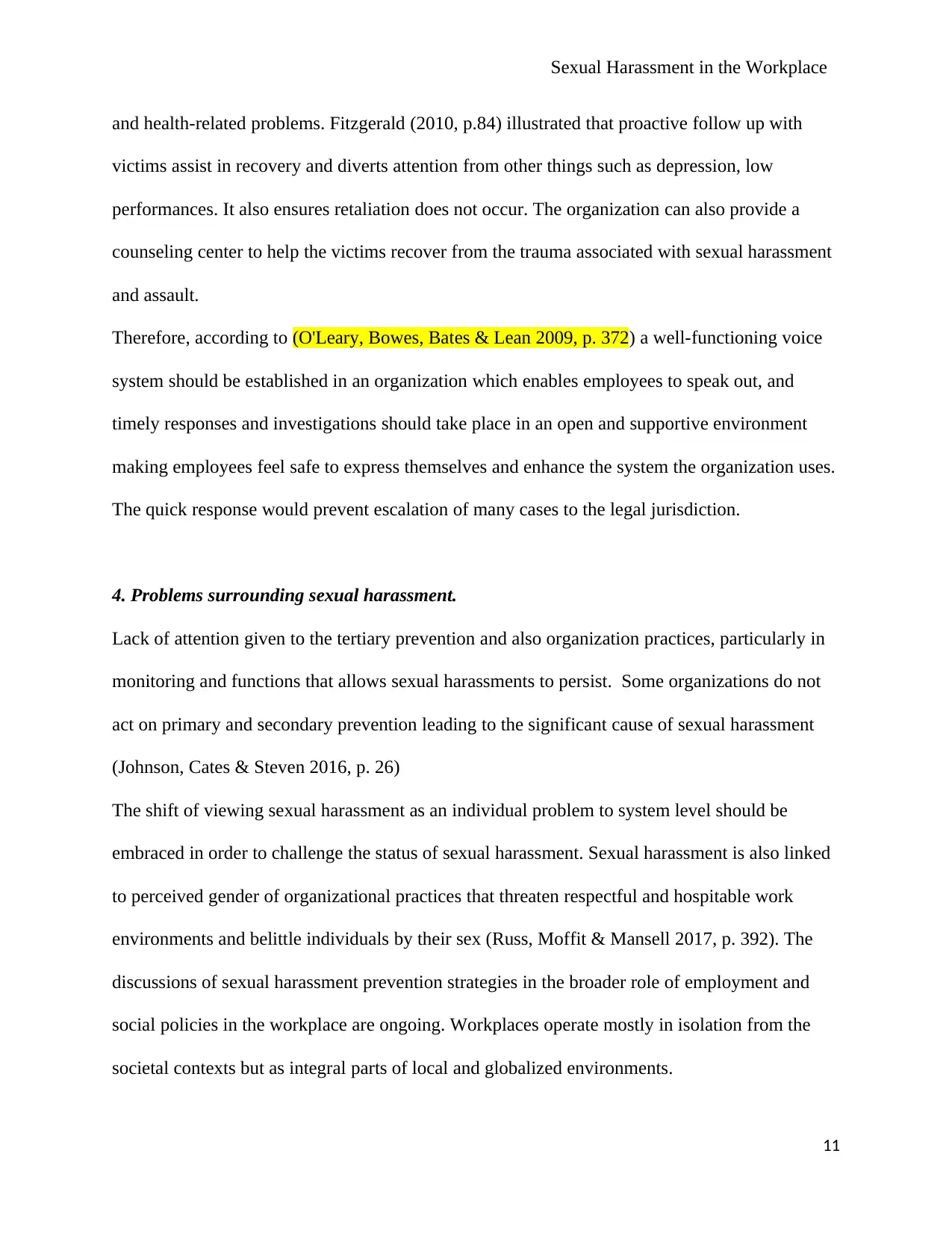
Sexual Harassment in the Workplace
and health-related problems. Fitzgerald (2010, p.84) illustrated that proactive follow up with
victims assist in recovery and diverts attention from other things such as depression, low
performances. It also ensures retaliation does not occur. The organization can also provide a
counseling center to help the victims recover from the trauma associated with sexual harassment
and assault.
Therefore, according to (O'Leary, Bowes, Bates & Lean 2009, p. 372) a well-functioning voice
system should be established in an organization which enables employees to speak out, and
timely responses and investigations should take place in an open and supportive environment
making employees feel safe to express themselves and enhance the system the organization uses.
The quick response would prevent escalation of many cases to the legal jurisdiction.
4. Problems surrounding sexual harassment.
Lack of attention given to the tertiary prevention and also organization practices, particularly in
monitoring and functions that allows sexual harassments to persist. Some organizations do not
act on primary and secondary prevention leading to the significant cause of sexual harassment
(Johnson, Cates & Steven 2016, p. 26)
The shift of viewing sexual harassment as an individual problem to system level should be
embraced in order to challenge the status of sexual harassment. Sexual harassment is also linked
to perceived gender of organizational practices that threaten respectful and hospitable work
environments and belittle individuals by their sex (Russ, Moffit & Mansell 2017, p. 392). The
discussions of sexual harassment prevention strategies in the broader role of employment and
social policies in the workplace are ongoing. Workplaces operate mostly in isolation from the
societal contexts but as integral parts of local and globalized environments.
11
and health-related problems. Fitzgerald (2010, p.84) illustrated that proactive follow up with
victims assist in recovery and diverts attention from other things such as depression, low
performances. It also ensures retaliation does not occur. The organization can also provide a
counseling center to help the victims recover from the trauma associated with sexual harassment
and assault.
Therefore, according to (O'Leary, Bowes, Bates & Lean 2009, p. 372) a well-functioning voice
system should be established in an organization which enables employees to speak out, and
timely responses and investigations should take place in an open and supportive environment
making employees feel safe to express themselves and enhance the system the organization uses.
The quick response would prevent escalation of many cases to the legal jurisdiction.
4. Problems surrounding sexual harassment.
Lack of attention given to the tertiary prevention and also organization practices, particularly in
monitoring and functions that allows sexual harassments to persist. Some organizations do not
act on primary and secondary prevention leading to the significant cause of sexual harassment
(Johnson, Cates & Steven 2016, p. 26)
The shift of viewing sexual harassment as an individual problem to system level should be
embraced in order to challenge the status of sexual harassment. Sexual harassment is also linked
to perceived gender of organizational practices that threaten respectful and hospitable work
environments and belittle individuals by their sex (Russ, Moffit & Mansell 2017, p. 392). The
discussions of sexual harassment prevention strategies in the broader role of employment and
social policies in the workplace are ongoing. Workplaces operate mostly in isolation from the
societal contexts but as integral parts of local and globalized environments.
11
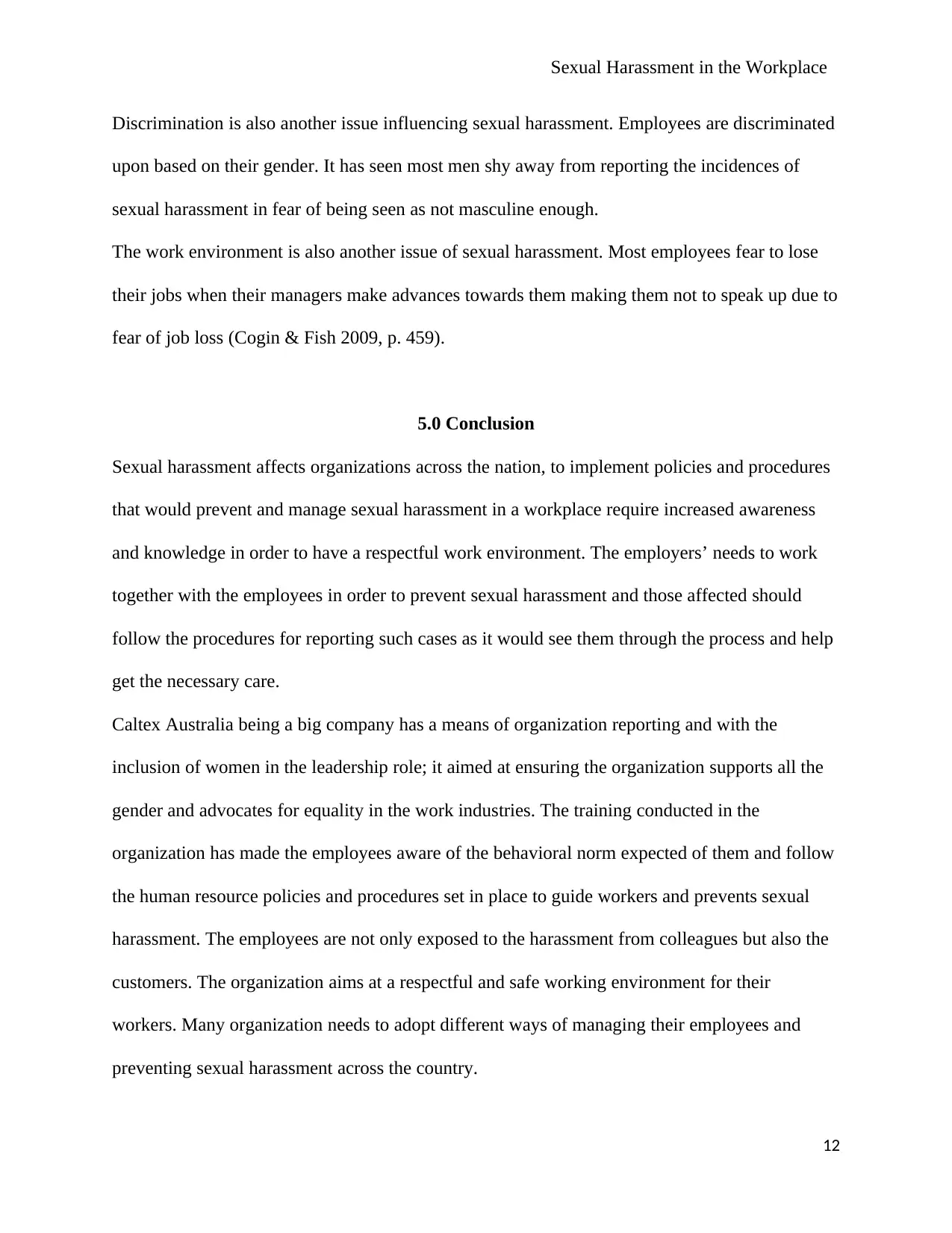
Sexual Harassment in the Workplace
Discrimination is also another issue influencing sexual harassment. Employees are discriminated
upon based on their gender. It has seen most men shy away from reporting the incidences of
sexual harassment in fear of being seen as not masculine enough.
The work environment is also another issue of sexual harassment. Most employees fear to lose
their jobs when their managers make advances towards them making them not to speak up due to
fear of job loss (Cogin & Fish 2009, p. 459).
5.0 Conclusion
Sexual harassment affects organizations across the nation, to implement policies and procedures
that would prevent and manage sexual harassment in a workplace require increased awareness
and knowledge in order to have a respectful work environment. The employers’ needs to work
together with the employees in order to prevent sexual harassment and those affected should
follow the procedures for reporting such cases as it would see them through the process and help
get the necessary care.
Caltex Australia being a big company has a means of organization reporting and with the
inclusion of women in the leadership role; it aimed at ensuring the organization supports all the
gender and advocates for equality in the work industries. The training conducted in the
organization has made the employees aware of the behavioral norm expected of them and follow
the human resource policies and procedures set in place to guide workers and prevents sexual
harassment. The employees are not only exposed to the harassment from colleagues but also the
customers. The organization aims at a respectful and safe working environment for their
workers. Many organization needs to adopt different ways of managing their employees and
preventing sexual harassment across the country.
12
Discrimination is also another issue influencing sexual harassment. Employees are discriminated
upon based on their gender. It has seen most men shy away from reporting the incidences of
sexual harassment in fear of being seen as not masculine enough.
The work environment is also another issue of sexual harassment. Most employees fear to lose
their jobs when their managers make advances towards them making them not to speak up due to
fear of job loss (Cogin & Fish 2009, p. 459).
5.0 Conclusion
Sexual harassment affects organizations across the nation, to implement policies and procedures
that would prevent and manage sexual harassment in a workplace require increased awareness
and knowledge in order to have a respectful work environment. The employers’ needs to work
together with the employees in order to prevent sexual harassment and those affected should
follow the procedures for reporting such cases as it would see them through the process and help
get the necessary care.
Caltex Australia being a big company has a means of organization reporting and with the
inclusion of women in the leadership role; it aimed at ensuring the organization supports all the
gender and advocates for equality in the work industries. The training conducted in the
organization has made the employees aware of the behavioral norm expected of them and follow
the human resource policies and procedures set in place to guide workers and prevents sexual
harassment. The employees are not only exposed to the harassment from colleagues but also the
customers. The organization aims at a respectful and safe working environment for their
workers. Many organization needs to adopt different ways of managing their employees and
preventing sexual harassment across the country.
12
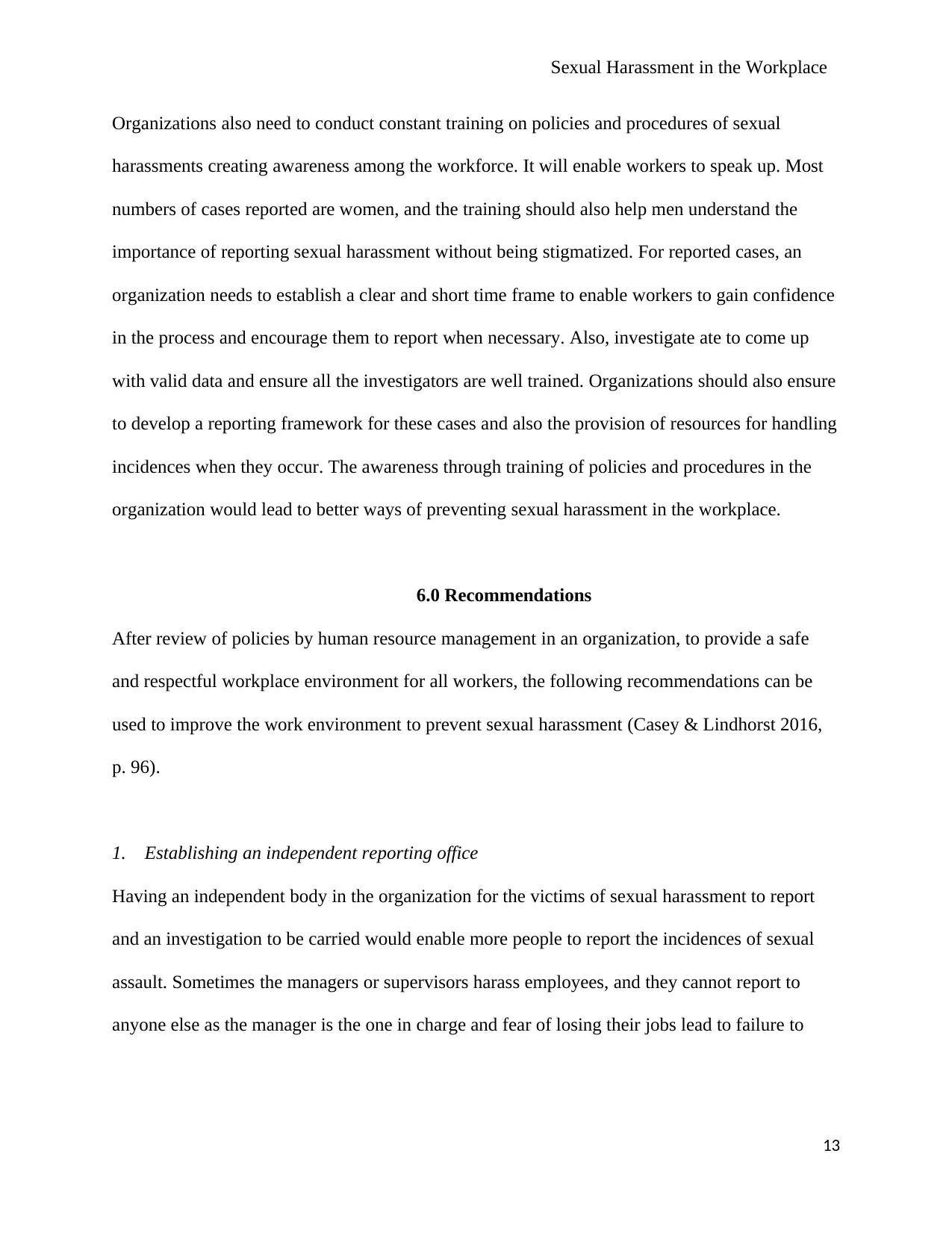
Sexual Harassment in the Workplace
Organizations also need to conduct constant training on policies and procedures of sexual
harassments creating awareness among the workforce. It will enable workers to speak up. Most
numbers of cases reported are women, and the training should also help men understand the
importance of reporting sexual harassment without being stigmatized. For reported cases, an
organization needs to establish a clear and short time frame to enable workers to gain confidence
in the process and encourage them to report when necessary. Also, investigate ate to come up
with valid data and ensure all the investigators are well trained. Organizations should also ensure
to develop a reporting framework for these cases and also the provision of resources for handling
incidences when they occur. The awareness through training of policies and procedures in the
organization would lead to better ways of preventing sexual harassment in the workplace.
6.0 Recommendations
After review of policies by human resource management in an organization, to provide a safe
and respectful workplace environment for all workers, the following recommendations can be
used to improve the work environment to prevent sexual harassment (Casey & Lindhorst 2016,
p. 96).
1. Establishing an independent reporting office
Having an independent body in the organization for the victims of sexual harassment to report
and an investigation to be carried would enable more people to report the incidences of sexual
assault. Sometimes the managers or supervisors harass employees, and they cannot report to
anyone else as the manager is the one in charge and fear of losing their jobs lead to failure to
13
Organizations also need to conduct constant training on policies and procedures of sexual
harassments creating awareness among the workforce. It will enable workers to speak up. Most
numbers of cases reported are women, and the training should also help men understand the
importance of reporting sexual harassment without being stigmatized. For reported cases, an
organization needs to establish a clear and short time frame to enable workers to gain confidence
in the process and encourage them to report when necessary. Also, investigate ate to come up
with valid data and ensure all the investigators are well trained. Organizations should also ensure
to develop a reporting framework for these cases and also the provision of resources for handling
incidences when they occur. The awareness through training of policies and procedures in the
organization would lead to better ways of preventing sexual harassment in the workplace.
6.0 Recommendations
After review of policies by human resource management in an organization, to provide a safe
and respectful workplace environment for all workers, the following recommendations can be
used to improve the work environment to prevent sexual harassment (Casey & Lindhorst 2016,
p. 96).
1. Establishing an independent reporting office
Having an independent body in the organization for the victims of sexual harassment to report
and an investigation to be carried would enable more people to report the incidences of sexual
assault. Sometimes the managers or supervisors harass employees, and they cannot report to
anyone else as the manager is the one in charge and fear of losing their jobs lead to failure to
13
Paraphrase This Document
Need a fresh take? Get an instant paraphrase of this document with our AI Paraphraser
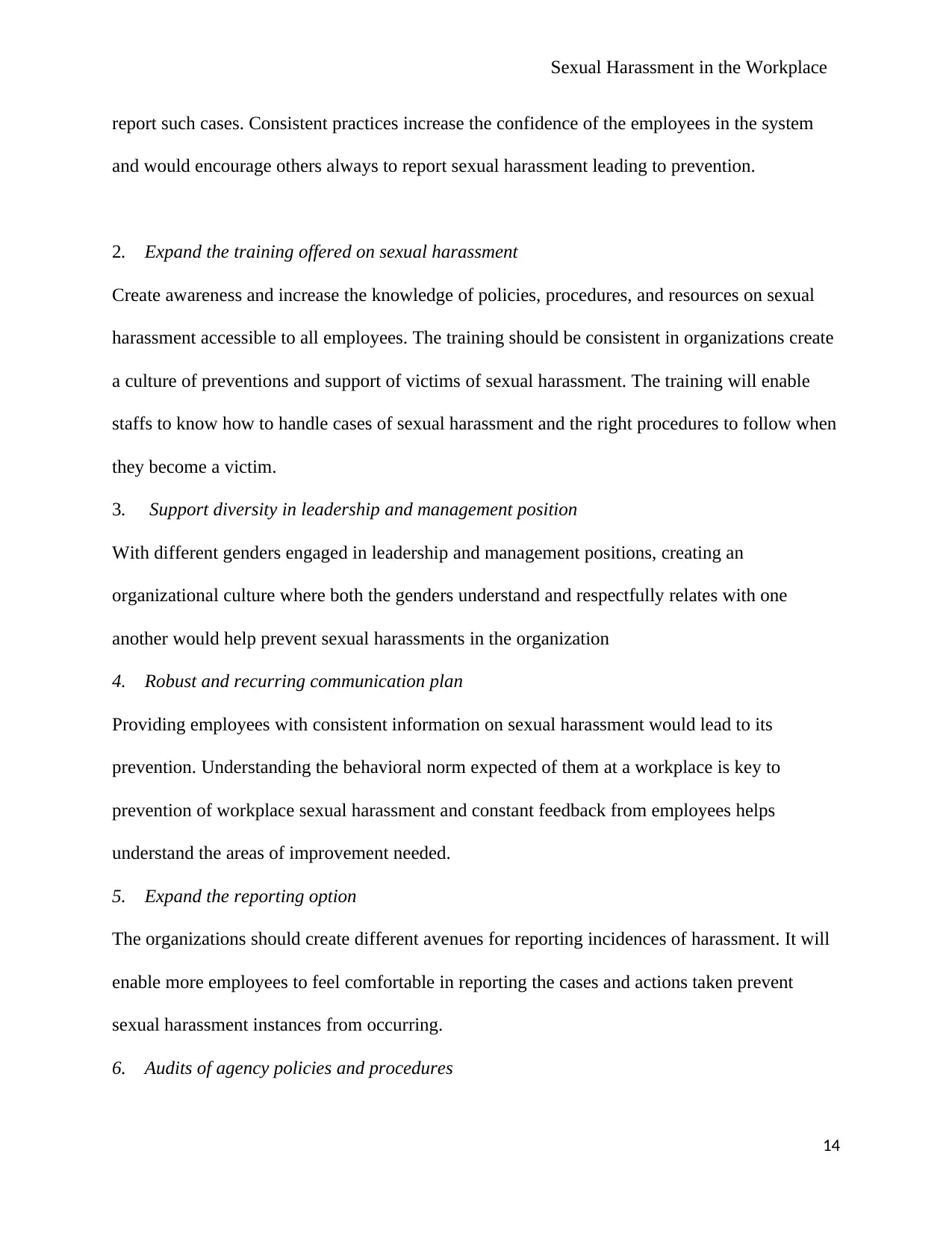
Sexual Harassment in the Workplace
report such cases. Consistent practices increase the confidence of the employees in the system
and would encourage others always to report sexual harassment leading to prevention.
2. Expand the training offered on sexual harassment
Create awareness and increase the knowledge of policies, procedures, and resources on sexual
harassment accessible to all employees. The training should be consistent in organizations create
a culture of preventions and support of victims of sexual harassment. The training will enable
staffs to know how to handle cases of sexual harassment and the right procedures to follow when
they become a victim.
3. Support diversity in leadership and management position
With different genders engaged in leadership and management positions, creating an
organizational culture where both the genders understand and respectfully relates with one
another would help prevent sexual harassments in the organization
4. Robust and recurring communication plan
Providing employees with consistent information on sexual harassment would lead to its
prevention. Understanding the behavioral norm expected of them at a workplace is key to
prevention of workplace sexual harassment and constant feedback from employees helps
understand the areas of improvement needed.
5. Expand the reporting option
The organizations should create different avenues for reporting incidences of harassment. It will
enable more employees to feel comfortable in reporting the cases and actions taken prevent
sexual harassment instances from occurring.
6. Audits of agency policies and procedures
14
report such cases. Consistent practices increase the confidence of the employees in the system
and would encourage others always to report sexual harassment leading to prevention.
2. Expand the training offered on sexual harassment
Create awareness and increase the knowledge of policies, procedures, and resources on sexual
harassment accessible to all employees. The training should be consistent in organizations create
a culture of preventions and support of victims of sexual harassment. The training will enable
staffs to know how to handle cases of sexual harassment and the right procedures to follow when
they become a victim.
3. Support diversity in leadership and management position
With different genders engaged in leadership and management positions, creating an
organizational culture where both the genders understand and respectfully relates with one
another would help prevent sexual harassments in the organization
4. Robust and recurring communication plan
Providing employees with consistent information on sexual harassment would lead to its
prevention. Understanding the behavioral norm expected of them at a workplace is key to
prevention of workplace sexual harassment and constant feedback from employees helps
understand the areas of improvement needed.
5. Expand the reporting option
The organizations should create different avenues for reporting incidences of harassment. It will
enable more employees to feel comfortable in reporting the cases and actions taken prevent
sexual harassment instances from occurring.
6. Audits of agency policies and procedures
14
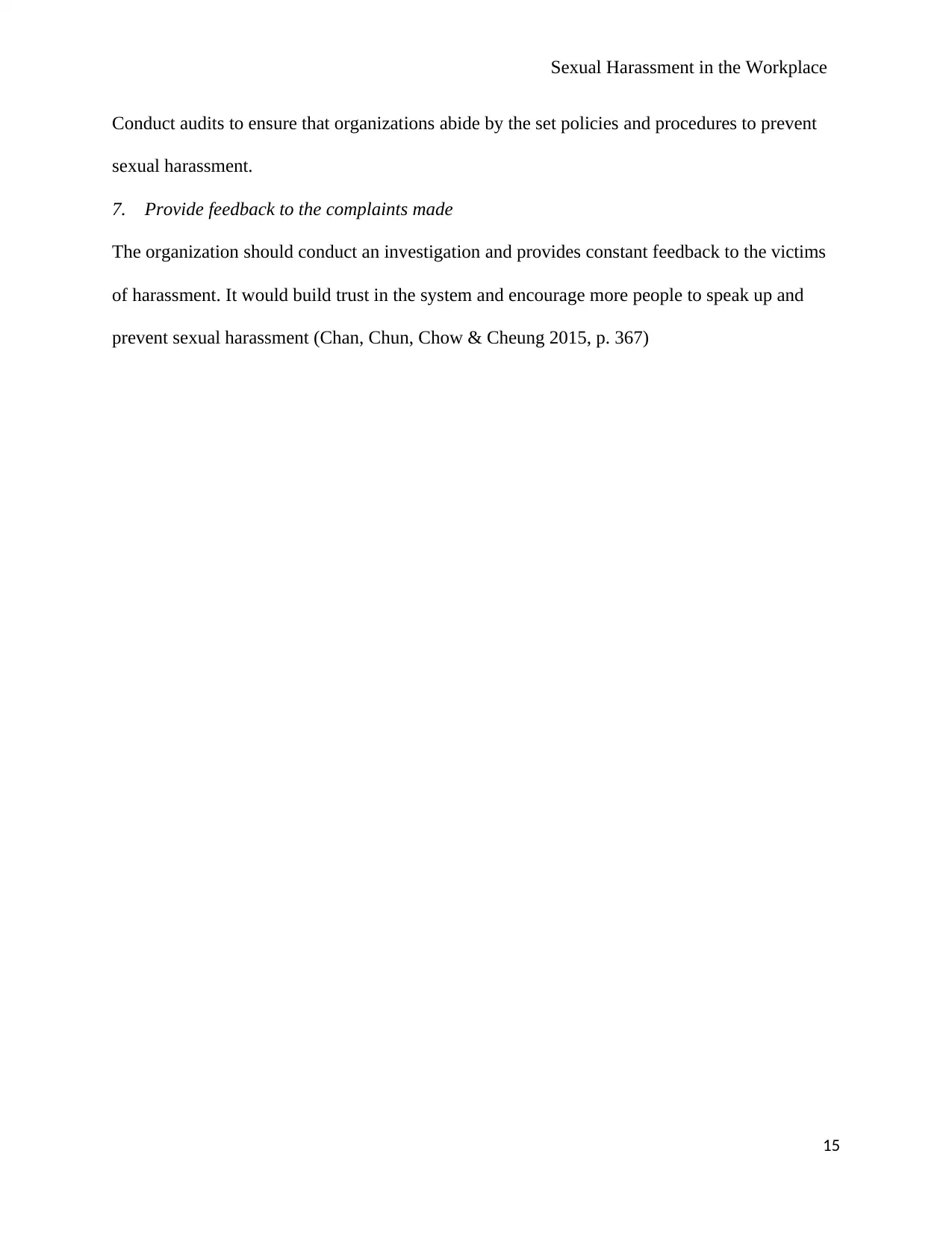
Sexual Harassment in the Workplace
Conduct audits to ensure that organizations abide by the set policies and procedures to prevent
sexual harassment.
7. Provide feedback to the complaints made
The organization should conduct an investigation and provides constant feedback to the victims
of harassment. It would build trust in the system and encourage more people to speak up and
prevent sexual harassment (Chan, Chun, Chow & Cheung 2015, p. 367)
15
Conduct audits to ensure that organizations abide by the set policies and procedures to prevent
sexual harassment.
7. Provide feedback to the complaints made
The organization should conduct an investigation and provides constant feedback to the victims
of harassment. It would build trust in the system and encourage more people to speak up and
prevent sexual harassment (Chan, Chun, Chow & Cheung 2015, p. 367)
15
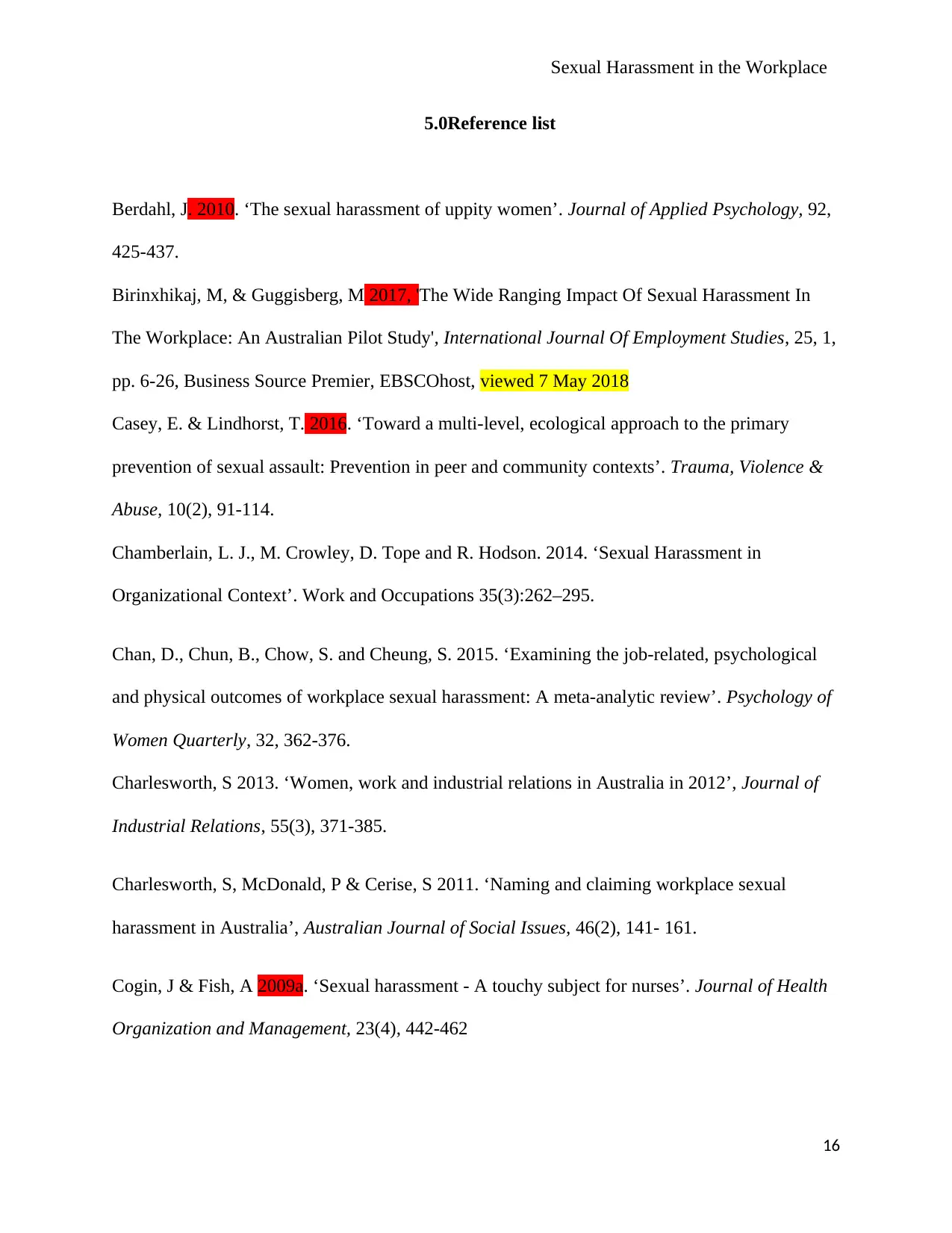
Sexual Harassment in the Workplace
5.0Reference list
Berdahl, J. 2010. ‘The sexual harassment of uppity women’. Journal of Applied Psychology, 92,
425-437.
Birinxhikaj, M, & Guggisberg, M 2017, 'The Wide Ranging Impact Of Sexual Harassment In
The Workplace: An Australian Pilot Study', International Journal Of Employment Studies, 25, 1,
pp. 6-26, Business Source Premier, EBSCOhost, viewed 7 May 2018
Casey, E. & Lindhorst, T. 2016. ‘Toward a multi-level, ecological approach to the primary
prevention of sexual assault: Prevention in peer and community contexts’. Trauma, Violence &
Abuse, 10(2), 91-114.
Chamberlain, L. J., M. Crowley, D. Tope and R. Hodson. 2014. ‘Sexual Harassment in
Organizational Context’. Work and Occupations 35(3):262–295.
Chan, D., Chun, B., Chow, S. and Cheung, S. 2015. ‘Examining the job-related, psychological
and physical outcomes of workplace sexual harassment: A meta-analytic review’. Psychology of
Women Quarterly, 32, 362-376.
Charlesworth, S 2013. ‘Women, work and industrial relations in Australia in 2012’, Journal of
Industrial Relations, 55(3), 371-385.
Charlesworth, S, McDonald, P & Cerise, S 2011. ‘Naming and claiming workplace sexual
harassment in Australia’, Australian Journal of Social Issues, 46(2), 141- 161.
Cogin, J & Fish, A 2009a. ‘Sexual harassment - A touchy subject for nurses’. Journal of Health
Organization and Management, 23(4), 442-462
16
5.0Reference list
Berdahl, J. 2010. ‘The sexual harassment of uppity women’. Journal of Applied Psychology, 92,
425-437.
Birinxhikaj, M, & Guggisberg, M 2017, 'The Wide Ranging Impact Of Sexual Harassment In
The Workplace: An Australian Pilot Study', International Journal Of Employment Studies, 25, 1,
pp. 6-26, Business Source Premier, EBSCOhost, viewed 7 May 2018
Casey, E. & Lindhorst, T. 2016. ‘Toward a multi-level, ecological approach to the primary
prevention of sexual assault: Prevention in peer and community contexts’. Trauma, Violence &
Abuse, 10(2), 91-114.
Chamberlain, L. J., M. Crowley, D. Tope and R. Hodson. 2014. ‘Sexual Harassment in
Organizational Context’. Work and Occupations 35(3):262–295.
Chan, D., Chun, B., Chow, S. and Cheung, S. 2015. ‘Examining the job-related, psychological
and physical outcomes of workplace sexual harassment: A meta-analytic review’. Psychology of
Women Quarterly, 32, 362-376.
Charlesworth, S 2013. ‘Women, work and industrial relations in Australia in 2012’, Journal of
Industrial Relations, 55(3), 371-385.
Charlesworth, S, McDonald, P & Cerise, S 2011. ‘Naming and claiming workplace sexual
harassment in Australia’, Australian Journal of Social Issues, 46(2), 141- 161.
Cogin, J & Fish, A 2009a. ‘Sexual harassment - A touchy subject for nurses’. Journal of Health
Organization and Management, 23(4), 442-462
16
Secure Best Marks with AI Grader
Need help grading? Try our AI Grader for instant feedback on your assignments.
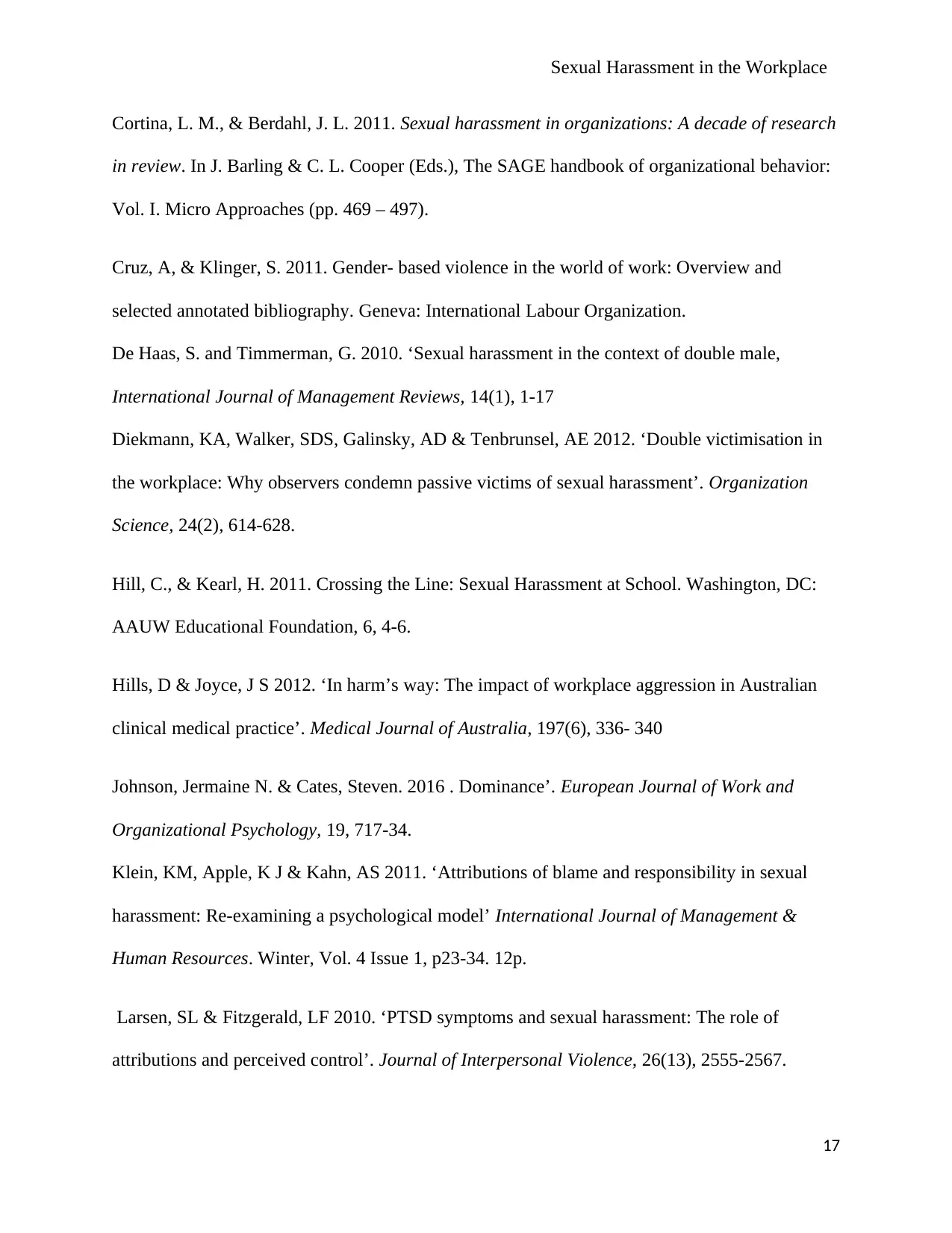
Sexual Harassment in the Workplace
Cortina, L. M., & Berdahl, J. L. 2011. Sexual harassment in organizations: A decade of research
in review. In J. Barling & C. L. Cooper (Eds.), The SAGE handbook of organizational behavior:
Vol. I. Micro Approaches (pp. 469 – 497).
Cruz, A, & Klinger, S. 2011. Gender- based violence in the world of work: Overview and
selected annotated bibliography. Geneva: International Labour Organization.
De Haas, S. and Timmerman, G. 2010. ‘Sexual harassment in the context of double male,
International Journal of Management Reviews, 14(1), 1-17
Diekmann, KA, Walker, SDS, Galinsky, AD & Tenbrunsel, AE 2012. ‘Double victimisation in
the workplace: Why observers condemn passive victims of sexual harassment’. Organization
Science, 24(2), 614-628.
Hill, C., & Kearl, H. 2011. Crossing the Line: Sexual Harassment at School. Washington, DC:
AAUW Educational Foundation, 6, 4-6.
Hills, D & Joyce, J S 2012. ‘In harm’s way: The impact of workplace aggression in Australian
clinical medical practice’. Medical Journal of Australia, 197(6), 336- 340
Johnson, Jermaine N. & Cates, Steven. 2016 . Dominance’. European Journal of Work and
Organizational Psychology, 19, 717-34.
Klein, KM, Apple, K J & Kahn, AS 2011. ‘Attributions of blame and responsibility in sexual
harassment: Re-examining a psychological model’ International Journal of Management &
Human Resources. Winter, Vol. 4 Issue 1, p23-34. 12p.
Larsen, SL & Fitzgerald, LF 2010. ‘PTSD symptoms and sexual harassment: The role of
attributions and perceived control’. Journal of Interpersonal Violence, 26(13), 2555-2567.
17
Cortina, L. M., & Berdahl, J. L. 2011. Sexual harassment in organizations: A decade of research
in review. In J. Barling & C. L. Cooper (Eds.), The SAGE handbook of organizational behavior:
Vol. I. Micro Approaches (pp. 469 – 497).
Cruz, A, & Klinger, S. 2011. Gender- based violence in the world of work: Overview and
selected annotated bibliography. Geneva: International Labour Organization.
De Haas, S. and Timmerman, G. 2010. ‘Sexual harassment in the context of double male,
International Journal of Management Reviews, 14(1), 1-17
Diekmann, KA, Walker, SDS, Galinsky, AD & Tenbrunsel, AE 2012. ‘Double victimisation in
the workplace: Why observers condemn passive victims of sexual harassment’. Organization
Science, 24(2), 614-628.
Hill, C., & Kearl, H. 2011. Crossing the Line: Sexual Harassment at School. Washington, DC:
AAUW Educational Foundation, 6, 4-6.
Hills, D & Joyce, J S 2012. ‘In harm’s way: The impact of workplace aggression in Australian
clinical medical practice’. Medical Journal of Australia, 197(6), 336- 340
Johnson, Jermaine N. & Cates, Steven. 2016 . Dominance’. European Journal of Work and
Organizational Psychology, 19, 717-34.
Klein, KM, Apple, K J & Kahn, AS 2011. ‘Attributions of blame and responsibility in sexual
harassment: Re-examining a psychological model’ International Journal of Management &
Human Resources. Winter, Vol. 4 Issue 1, p23-34. 12p.
Larsen, SL & Fitzgerald, LF 2010. ‘PTSD symptoms and sexual harassment: The role of
attributions and perceived control’. Journal of Interpersonal Violence, 26(13), 2555-2567.
17
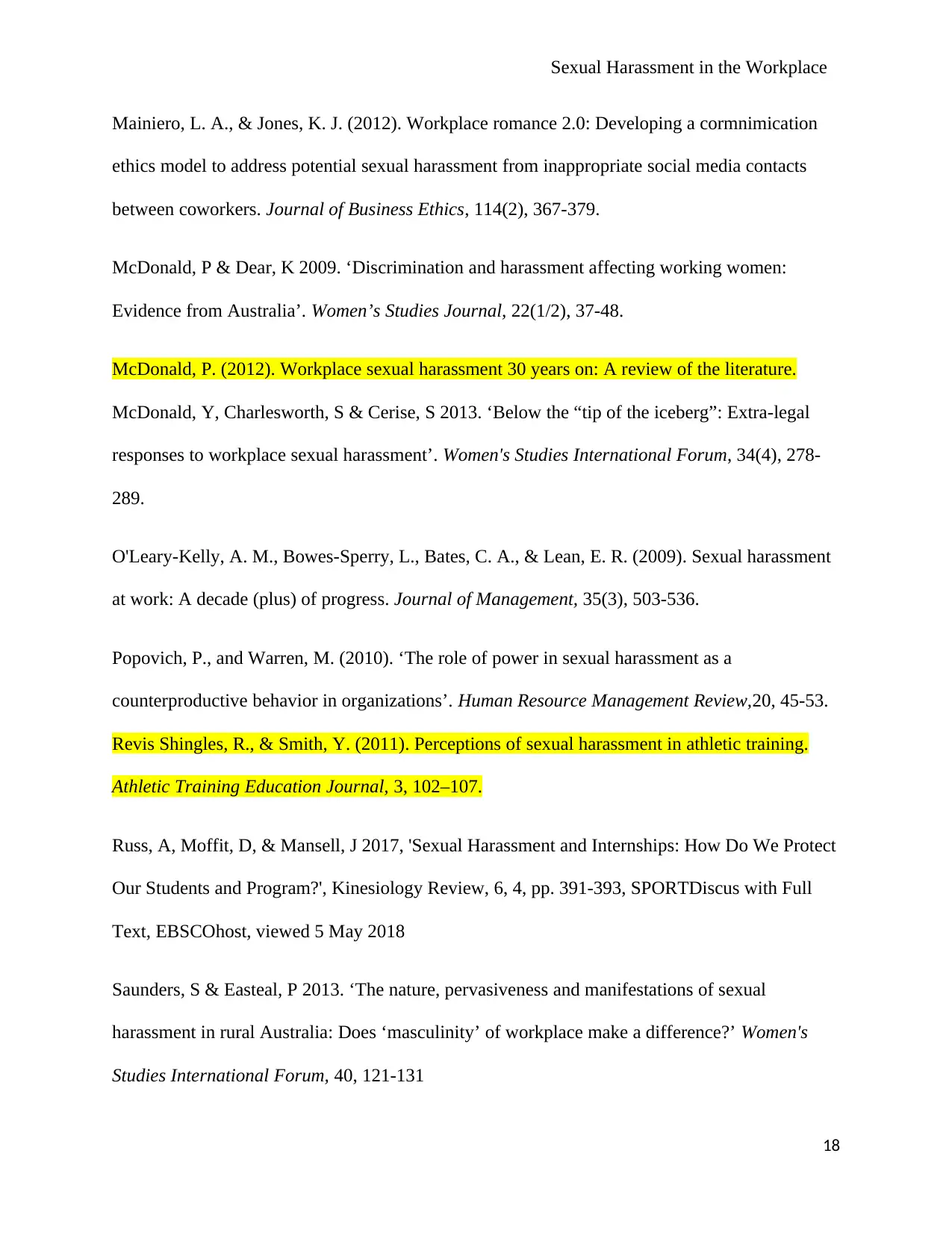
Sexual Harassment in the Workplace
Mainiero, L. A., & Jones, K. J. (2012). Workplace romance 2.0: Developing a cormnimication
ethics model to address potential sexual harassment from inappropriate social media contacts
between coworkers. Journal of Business Ethics, 114(2), 367-379.
McDonald, P & Dear, K 2009. ‘Discrimination and harassment affecting working women:
Evidence from Australia’. Women’s Studies Journal, 22(1/2), 37-48.
McDonald, P. (2012). Workplace sexual harassment 30 years on: A review of the literature.
McDonald, Y, Charlesworth, S & Cerise, S 2013. ‘Below the “tip of the iceberg”: Extra-legal
responses to workplace sexual harassment’. Women's Studies International Forum, 34(4), 278-
289.
O'Leary-Kelly, A. M., Bowes-Sperry, L., Bates, C. A., & Lean, E. R. (2009). Sexual harassment
at work: A decade (plus) of progress. Journal of Management, 35(3), 503-536.
Popovich, P., and Warren, M. (2010). ‘The role of power in sexual harassment as a
counterproductive behavior in organizations’. Human Resource Management Review,20, 45-53.
Revis Shingles, R., & Smith, Y. (2011). Perceptions of sexual harassment in athletic training.
Athletic Training Education Journal, 3, 102–107.
Russ, A, Moffit, D, & Mansell, J 2017, 'Sexual Harassment and Internships: How Do We Protect
Our Students and Program?', Kinesiology Review, 6, 4, pp. 391-393, SPORTDiscus with Full
Text, EBSCOhost, viewed 5 May 2018
Saunders, S & Easteal, P 2013. ‘The nature, pervasiveness and manifestations of sexual
harassment in rural Australia: Does ‘masculinity’ of workplace make a difference?’ Women's
Studies International Forum, 40, 121-131
18
Mainiero, L. A., & Jones, K. J. (2012). Workplace romance 2.0: Developing a cormnimication
ethics model to address potential sexual harassment from inappropriate social media contacts
between coworkers. Journal of Business Ethics, 114(2), 367-379.
McDonald, P & Dear, K 2009. ‘Discrimination and harassment affecting working women:
Evidence from Australia’. Women’s Studies Journal, 22(1/2), 37-48.
McDonald, P. (2012). Workplace sexual harassment 30 years on: A review of the literature.
McDonald, Y, Charlesworth, S & Cerise, S 2013. ‘Below the “tip of the iceberg”: Extra-legal
responses to workplace sexual harassment’. Women's Studies International Forum, 34(4), 278-
289.
O'Leary-Kelly, A. M., Bowes-Sperry, L., Bates, C. A., & Lean, E. R. (2009). Sexual harassment
at work: A decade (plus) of progress. Journal of Management, 35(3), 503-536.
Popovich, P., and Warren, M. (2010). ‘The role of power in sexual harassment as a
counterproductive behavior in organizations’. Human Resource Management Review,20, 45-53.
Revis Shingles, R., & Smith, Y. (2011). Perceptions of sexual harassment in athletic training.
Athletic Training Education Journal, 3, 102–107.
Russ, A, Moffit, D, & Mansell, J 2017, 'Sexual Harassment and Internships: How Do We Protect
Our Students and Program?', Kinesiology Review, 6, 4, pp. 391-393, SPORTDiscus with Full
Text, EBSCOhost, viewed 5 May 2018
Saunders, S & Easteal, P 2013. ‘The nature, pervasiveness and manifestations of sexual
harassment in rural Australia: Does ‘masculinity’ of workplace make a difference?’ Women's
Studies International Forum, 40, 121-131
18
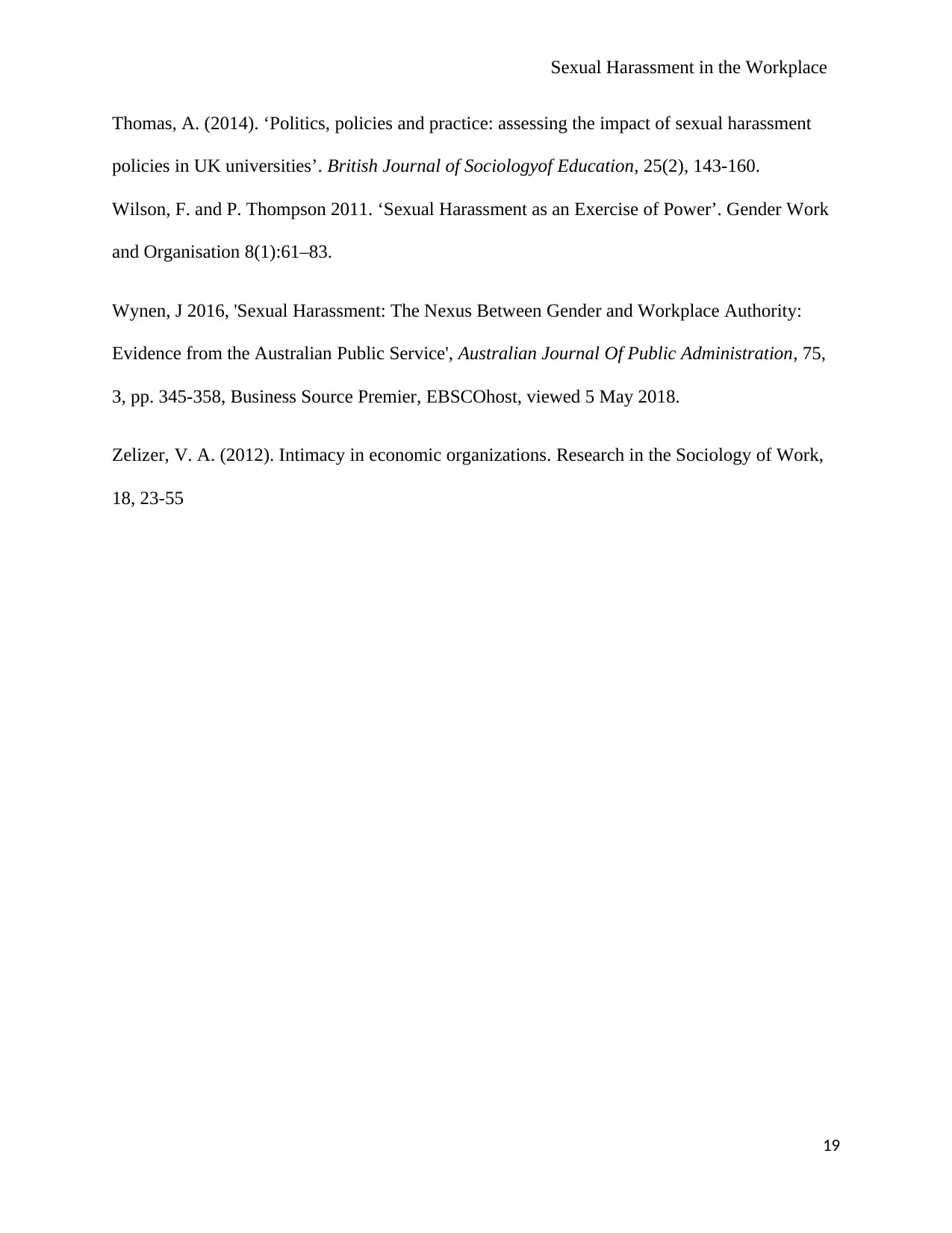
Sexual Harassment in the Workplace
Thomas, A. (2014). ‘Politics, policies and practice: assessing the impact of sexual harassment
policies in UK universities’. British Journal of Sociologyof Education, 25(2), 143-160.
Wilson, F. and P. Thompson 2011. ‘Sexual Harassment as an Exercise of Power’. Gender Work
and Organisation 8(1):61–83.
Wynen, J 2016, 'Sexual Harassment: The Nexus Between Gender and Workplace Authority:
Evidence from the Australian Public Service', Australian Journal Of Public Administration, 75,
3, pp. 345-358, Business Source Premier, EBSCOhost, viewed 5 May 2018.
Zelizer, V. A. (2012). Intimacy in economic organizations. Research in the Sociology of Work,
18, 23-55
19
Thomas, A. (2014). ‘Politics, policies and practice: assessing the impact of sexual harassment
policies in UK universities’. British Journal of Sociologyof Education, 25(2), 143-160.
Wilson, F. and P. Thompson 2011. ‘Sexual Harassment as an Exercise of Power’. Gender Work
and Organisation 8(1):61–83.
Wynen, J 2016, 'Sexual Harassment: The Nexus Between Gender and Workplace Authority:
Evidence from the Australian Public Service', Australian Journal Of Public Administration, 75,
3, pp. 345-358, Business Source Premier, EBSCOhost, viewed 5 May 2018.
Zelizer, V. A. (2012). Intimacy in economic organizations. Research in the Sociology of Work,
18, 23-55
19
1 out of 19
Your All-in-One AI-Powered Toolkit for Academic Success.
+13062052269
info@desklib.com
Available 24*7 on WhatsApp / Email
![[object Object]](/_next/static/media/star-bottom.7253800d.svg)
Unlock your academic potential
© 2024 | Zucol Services PVT LTD | All rights reserved.

